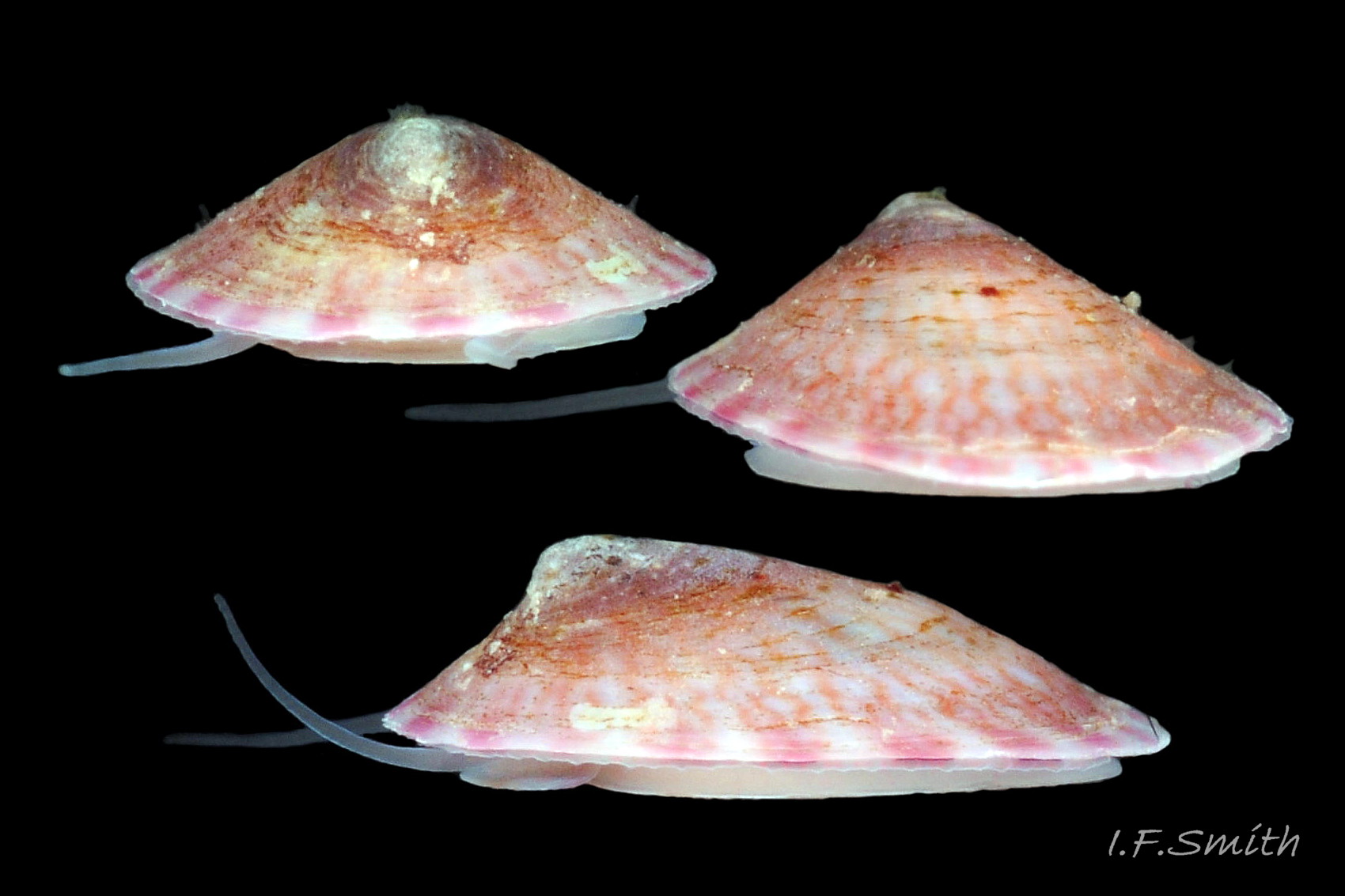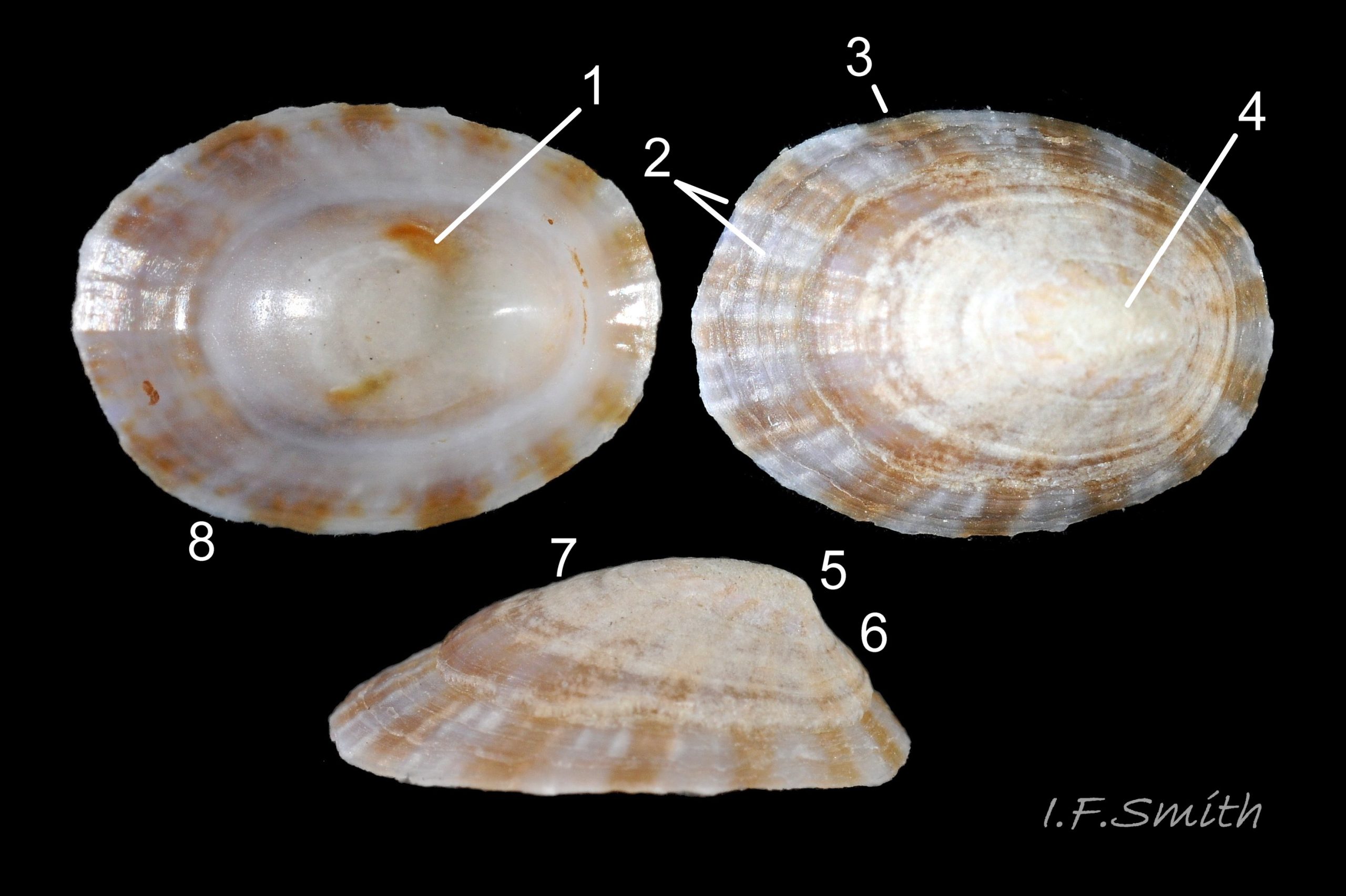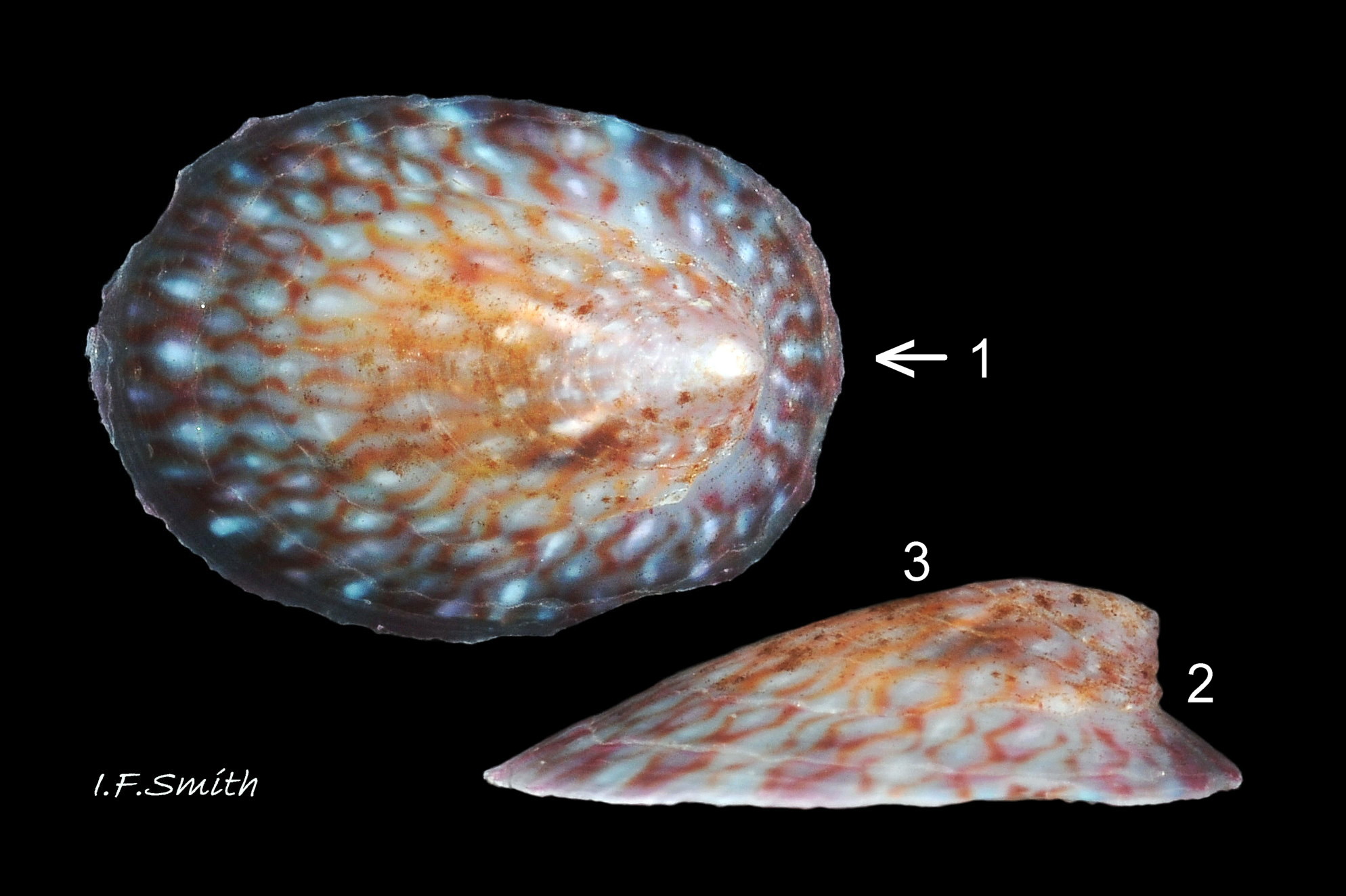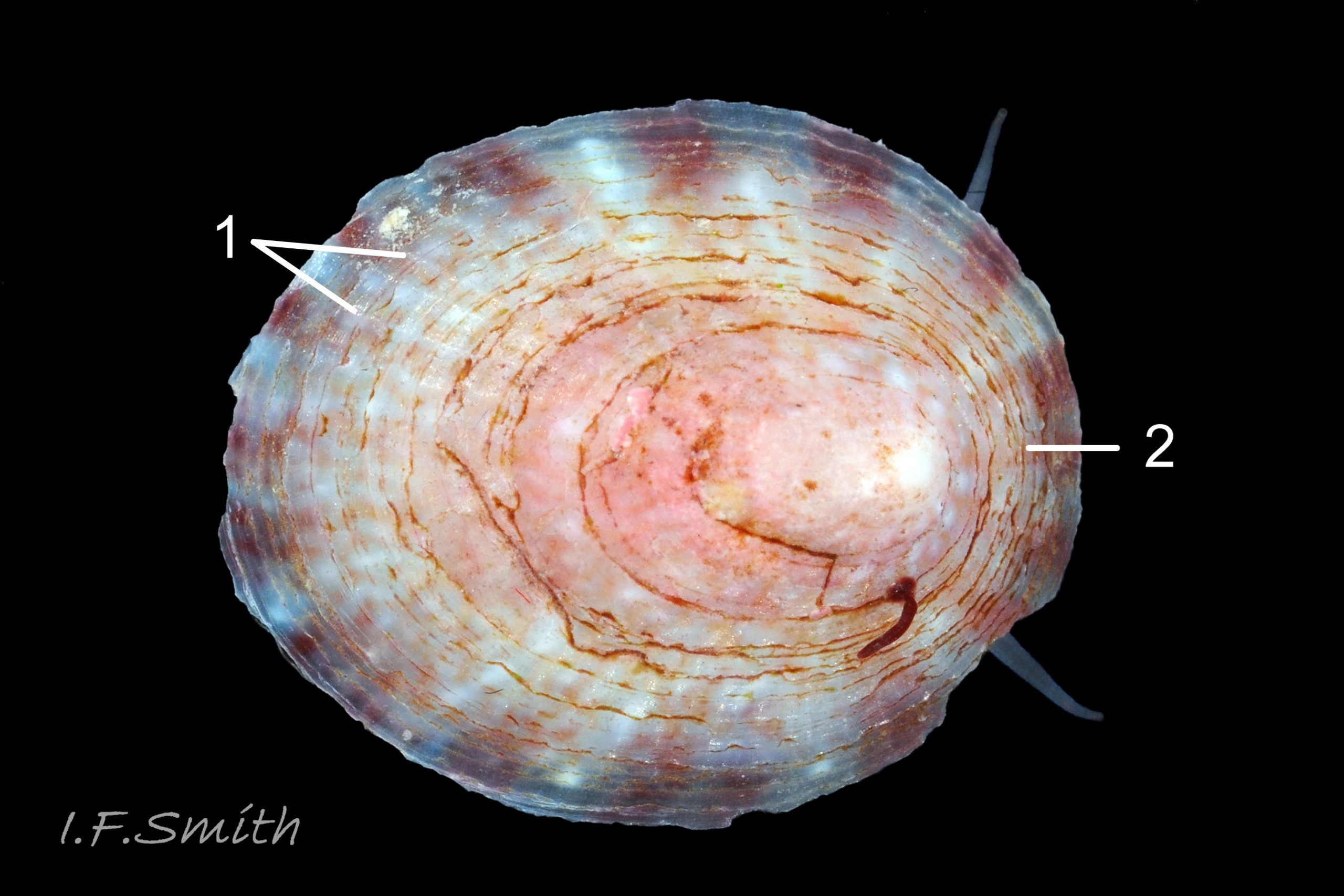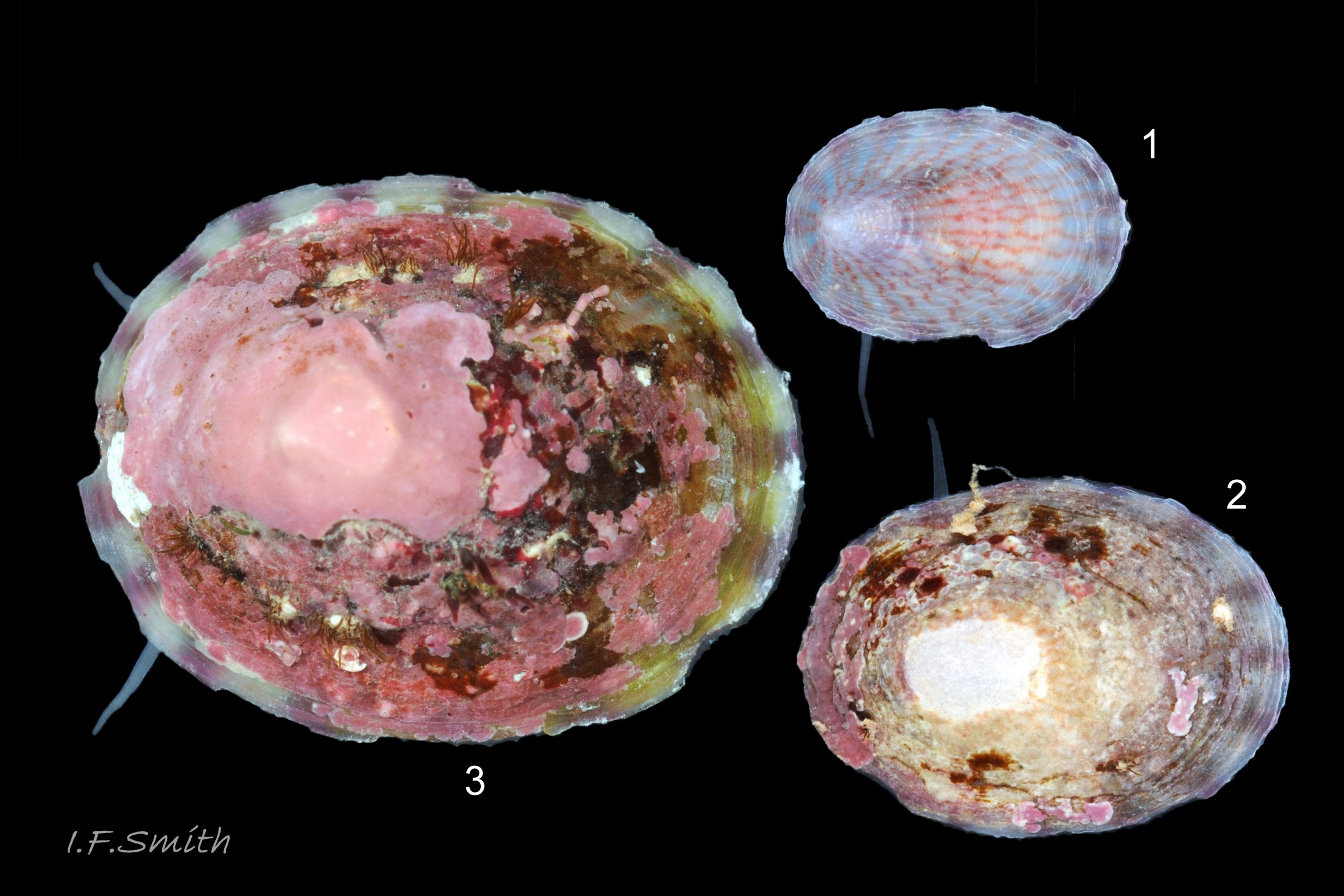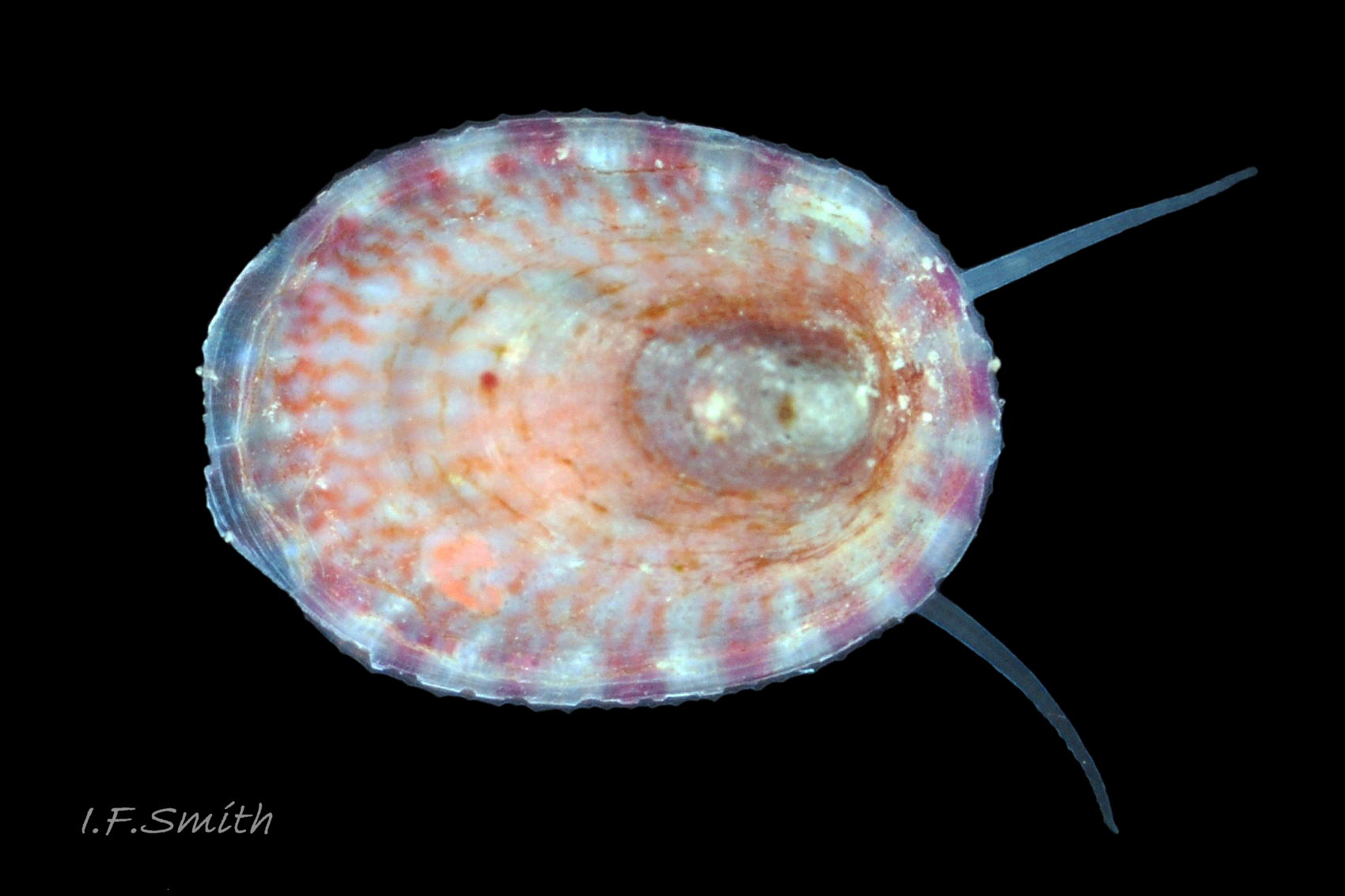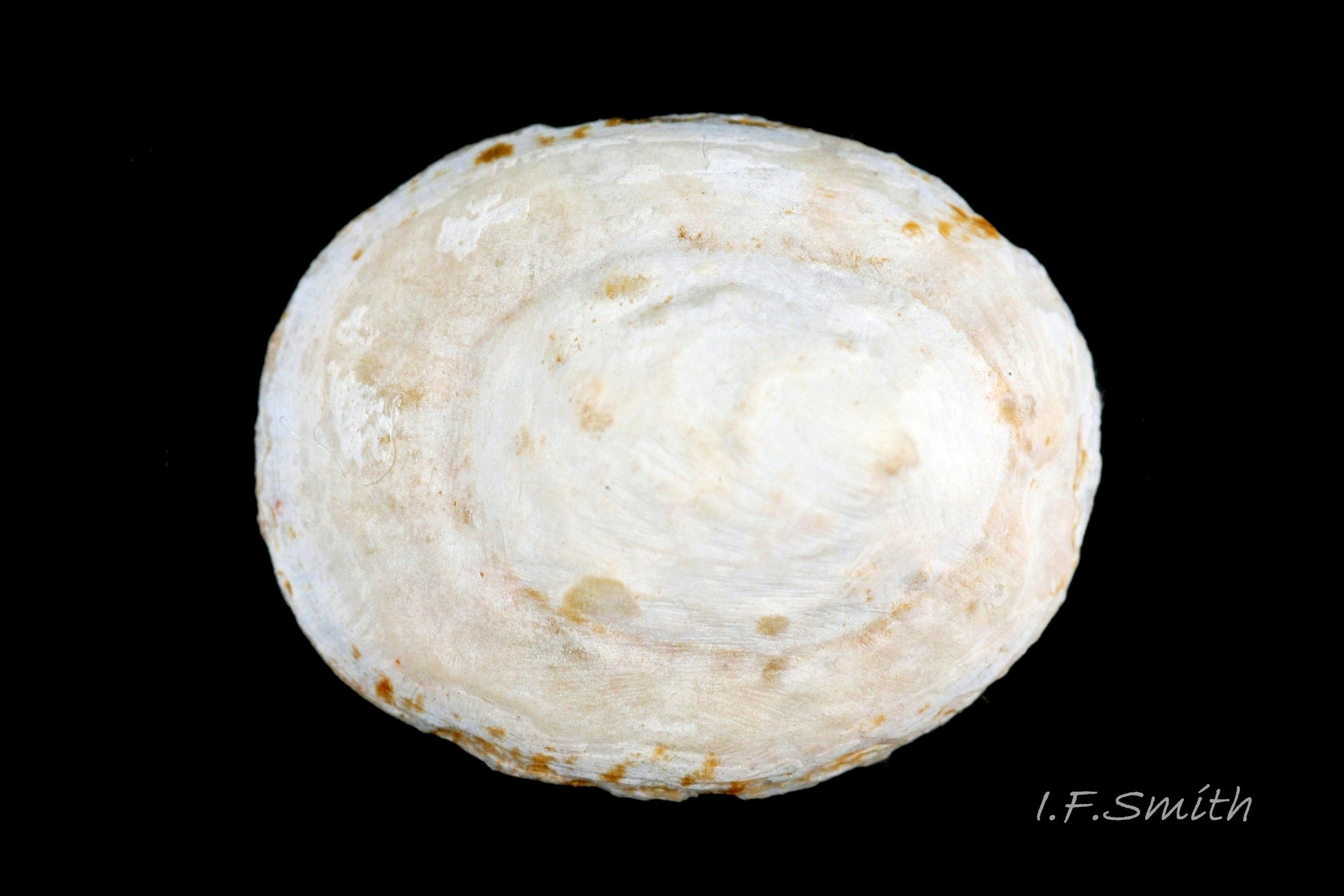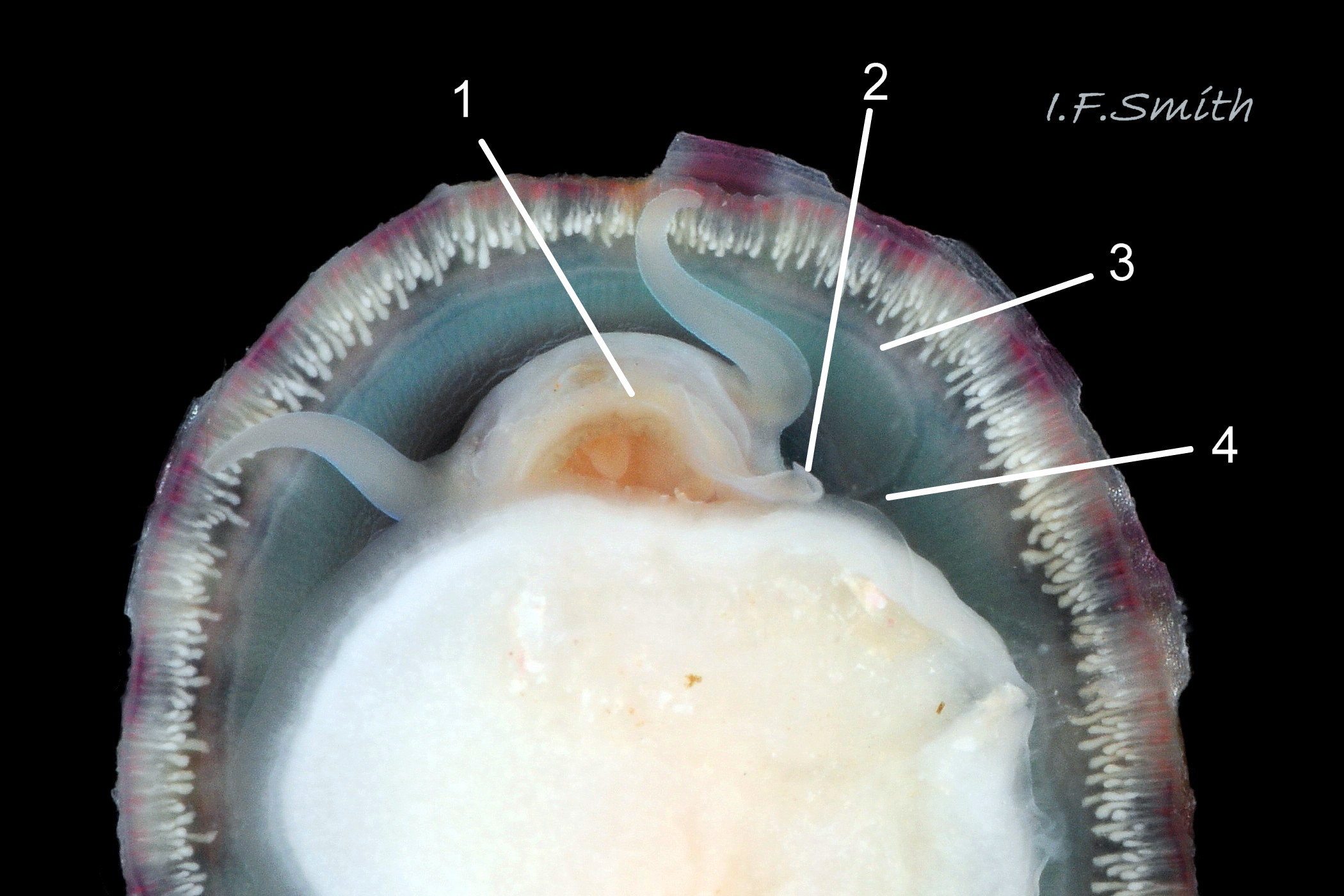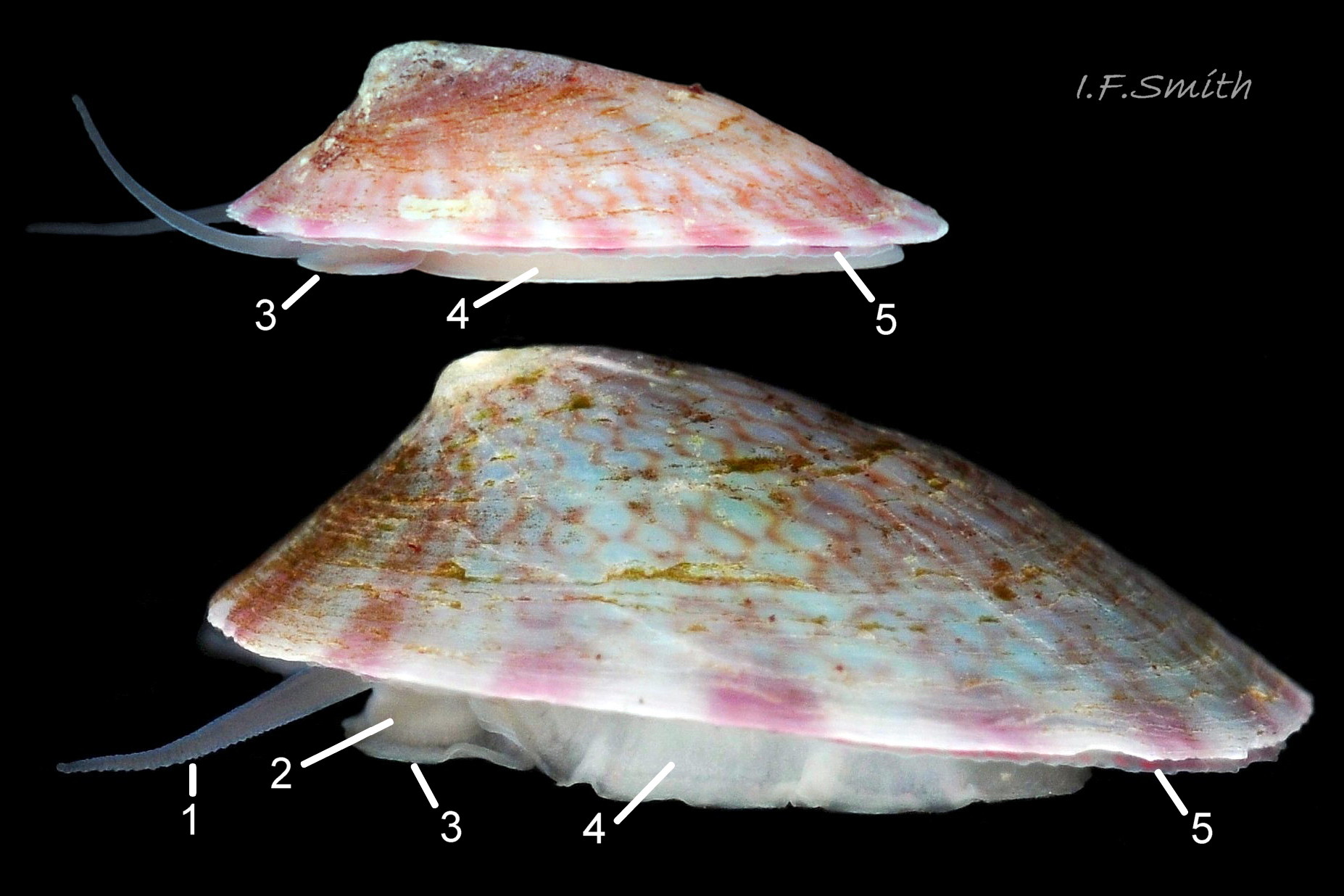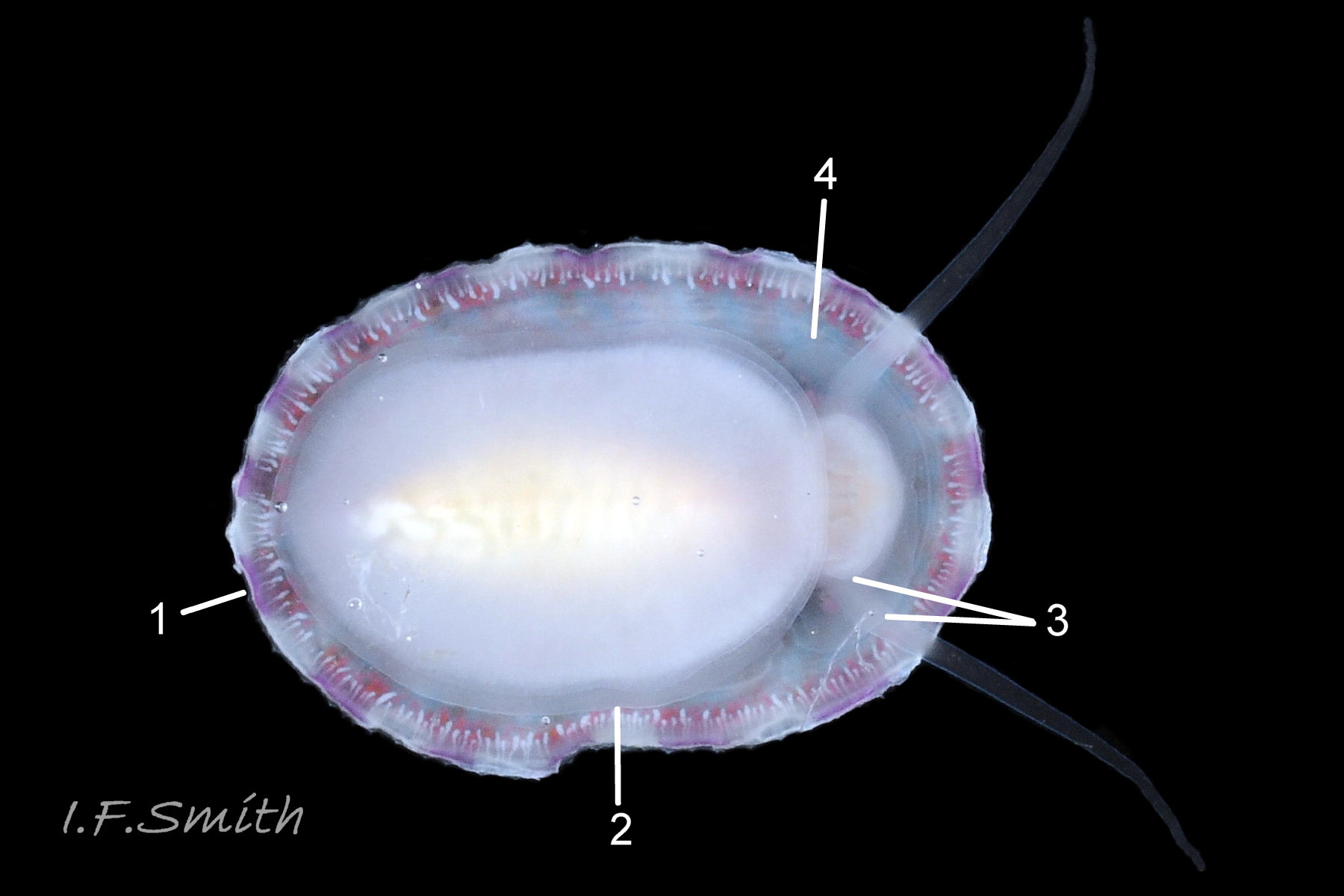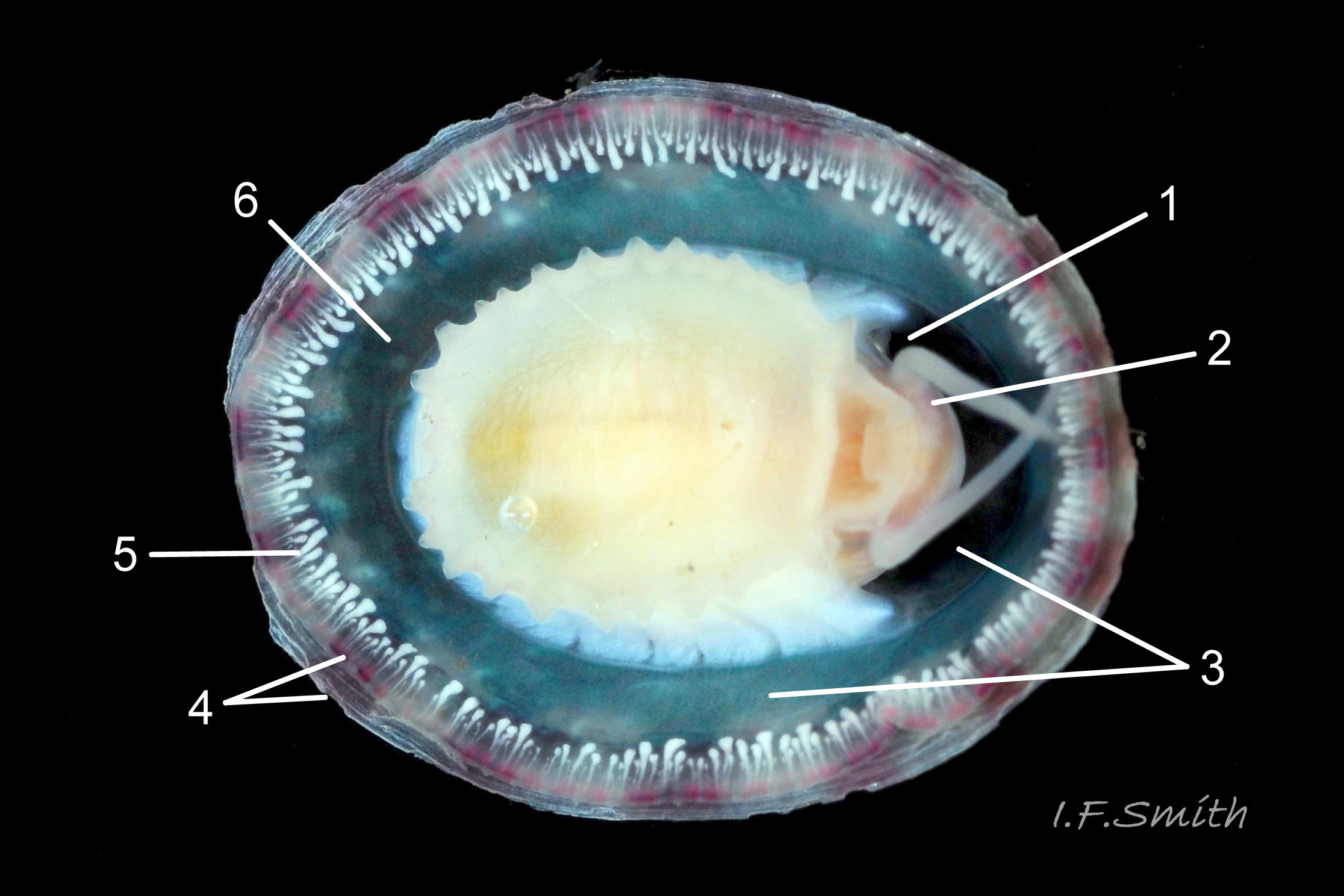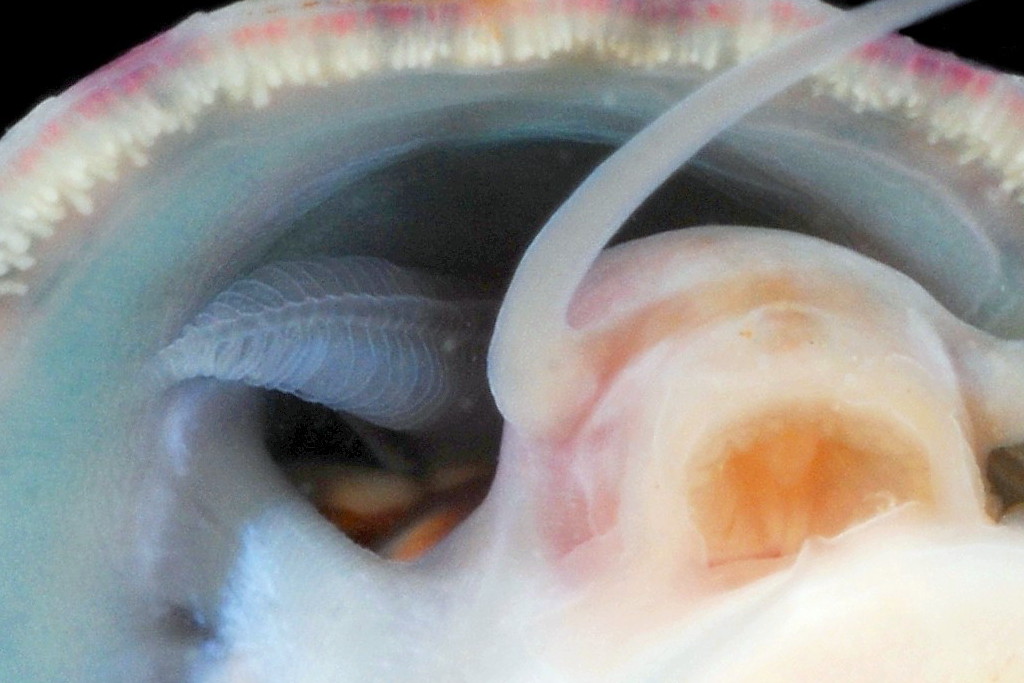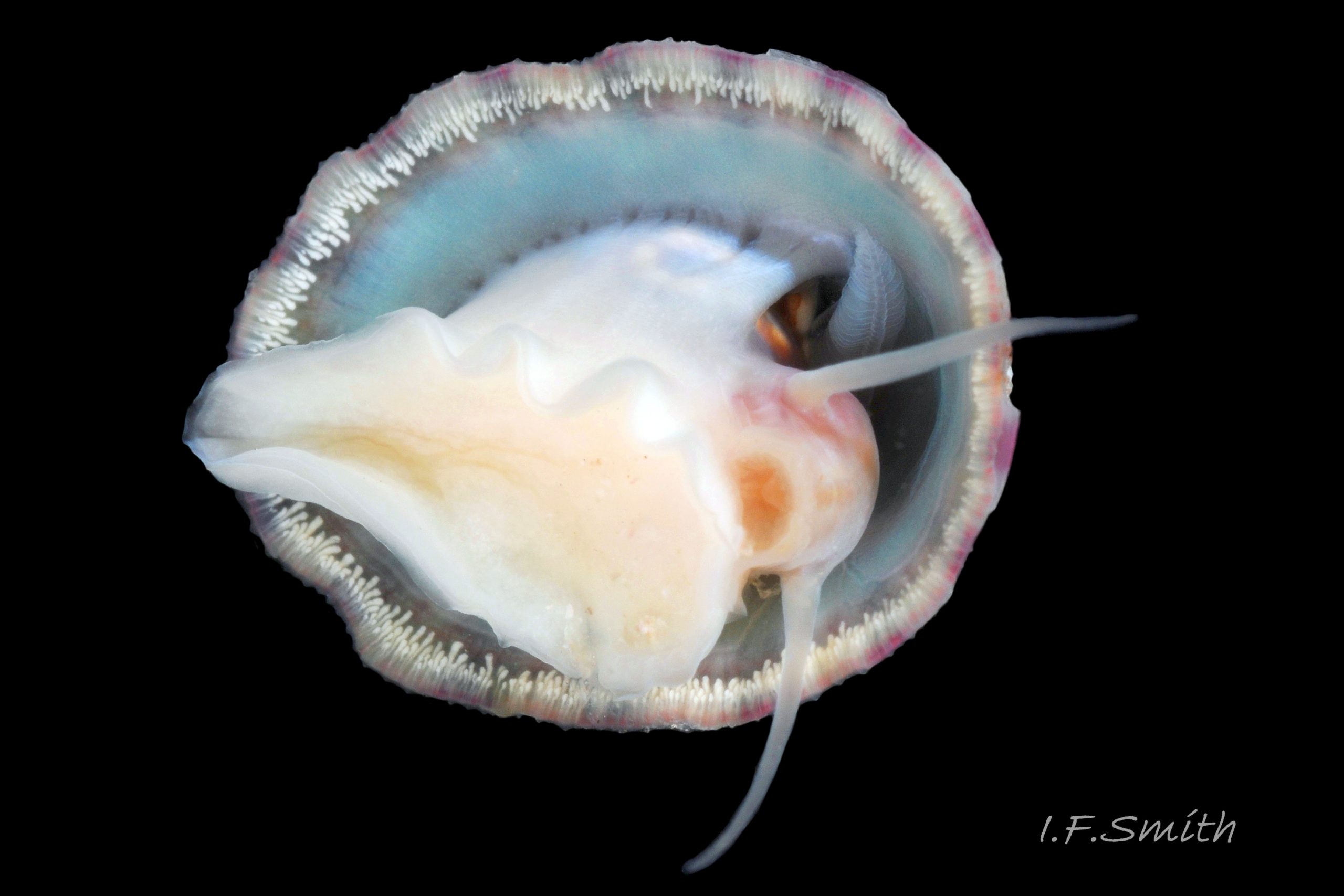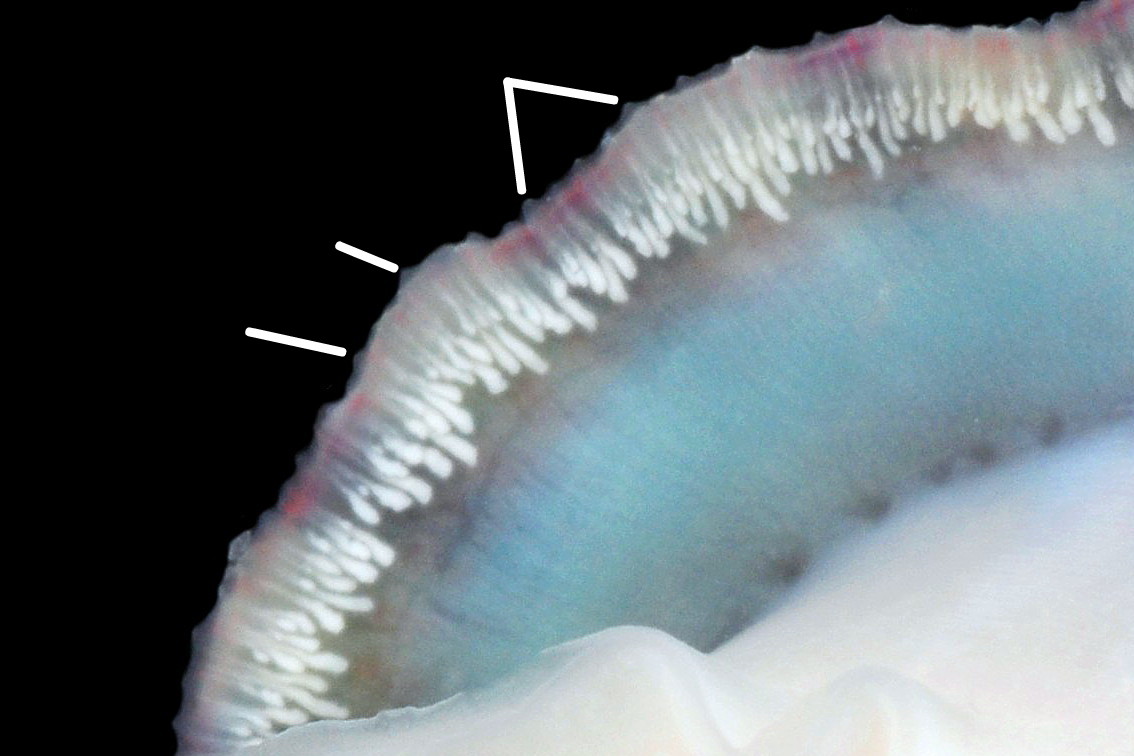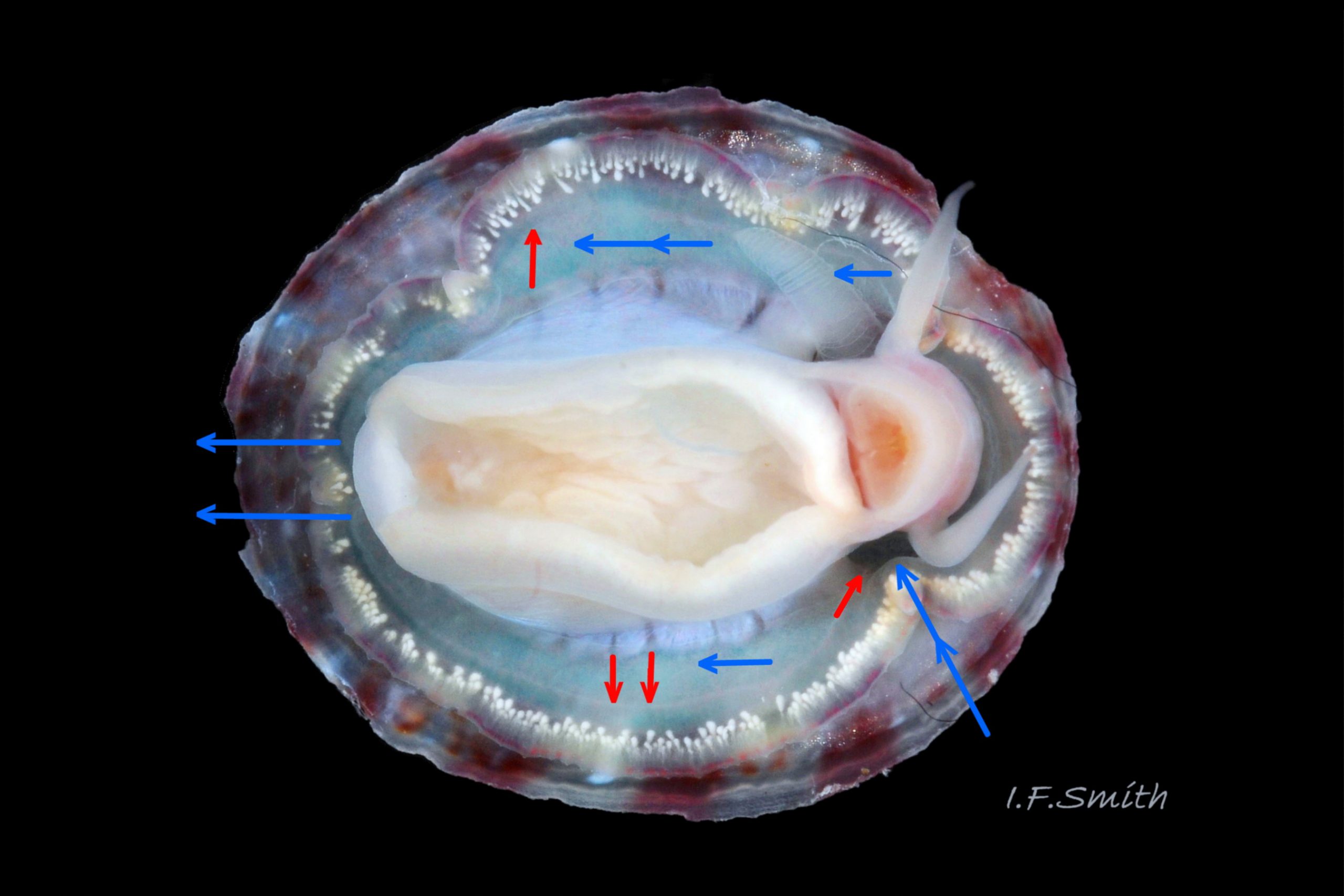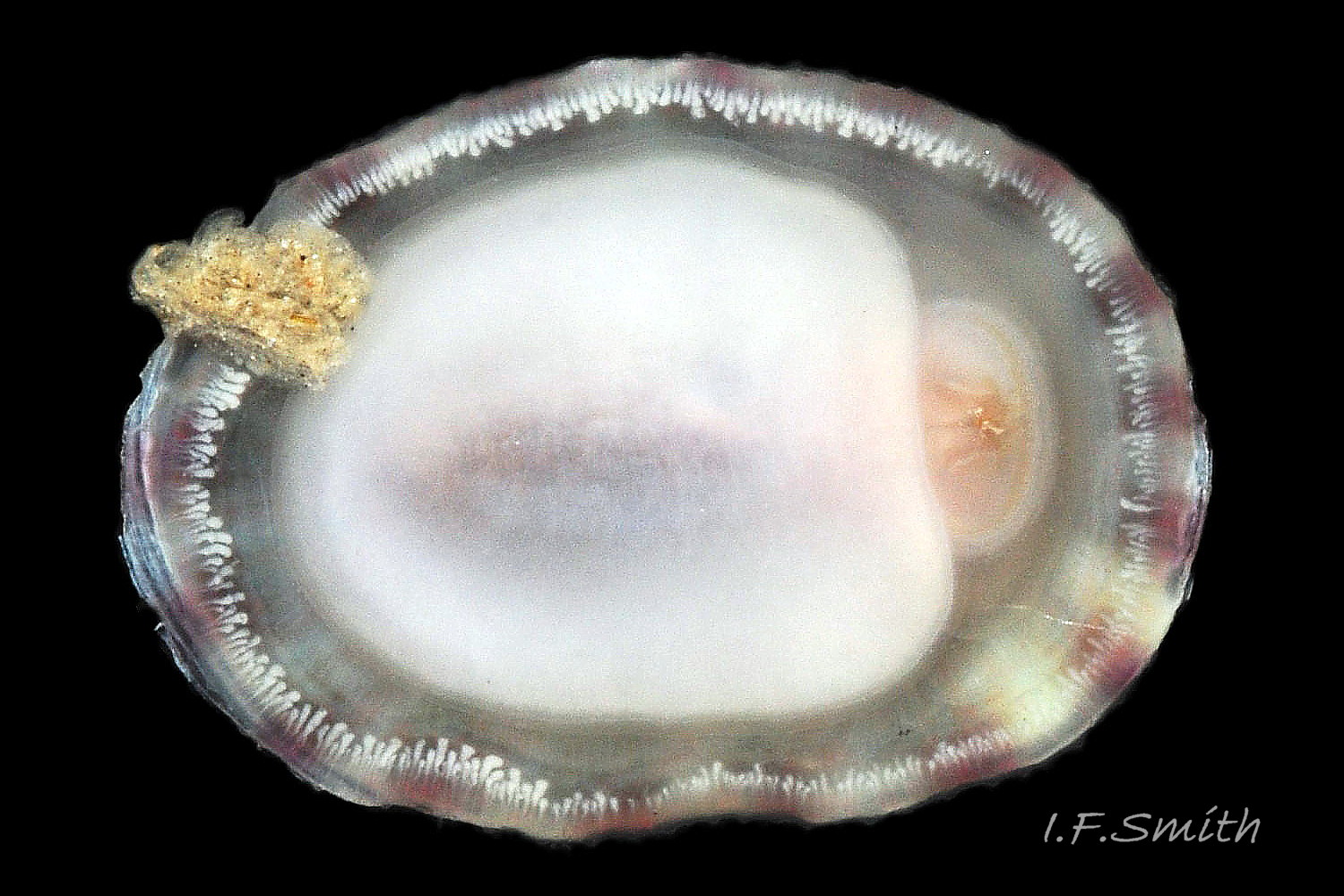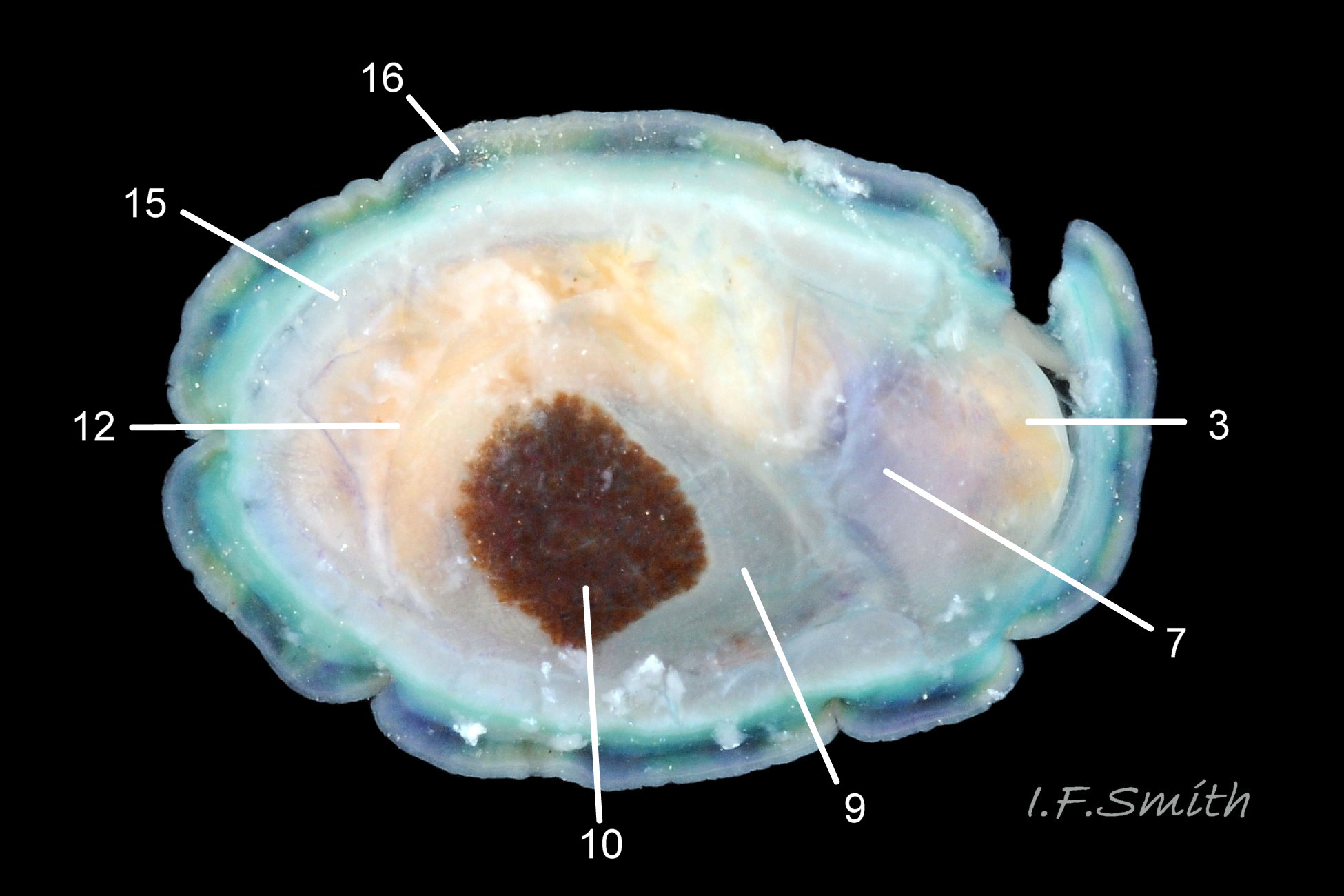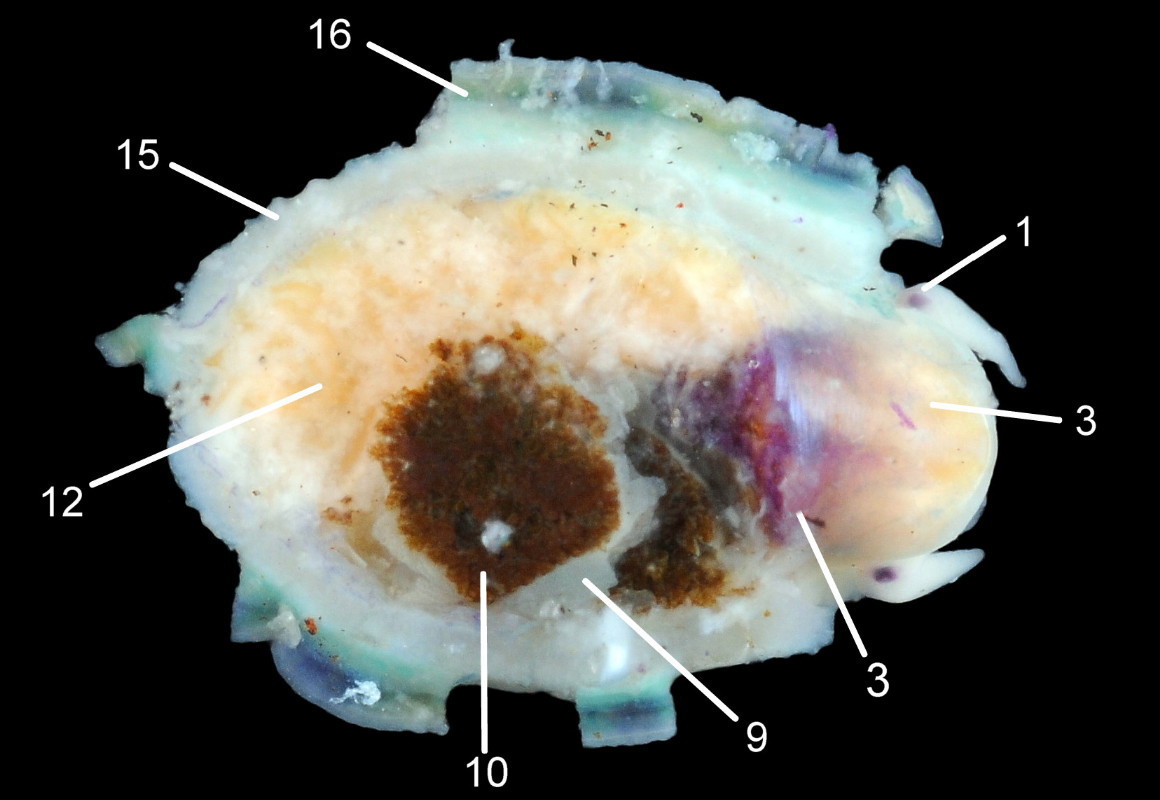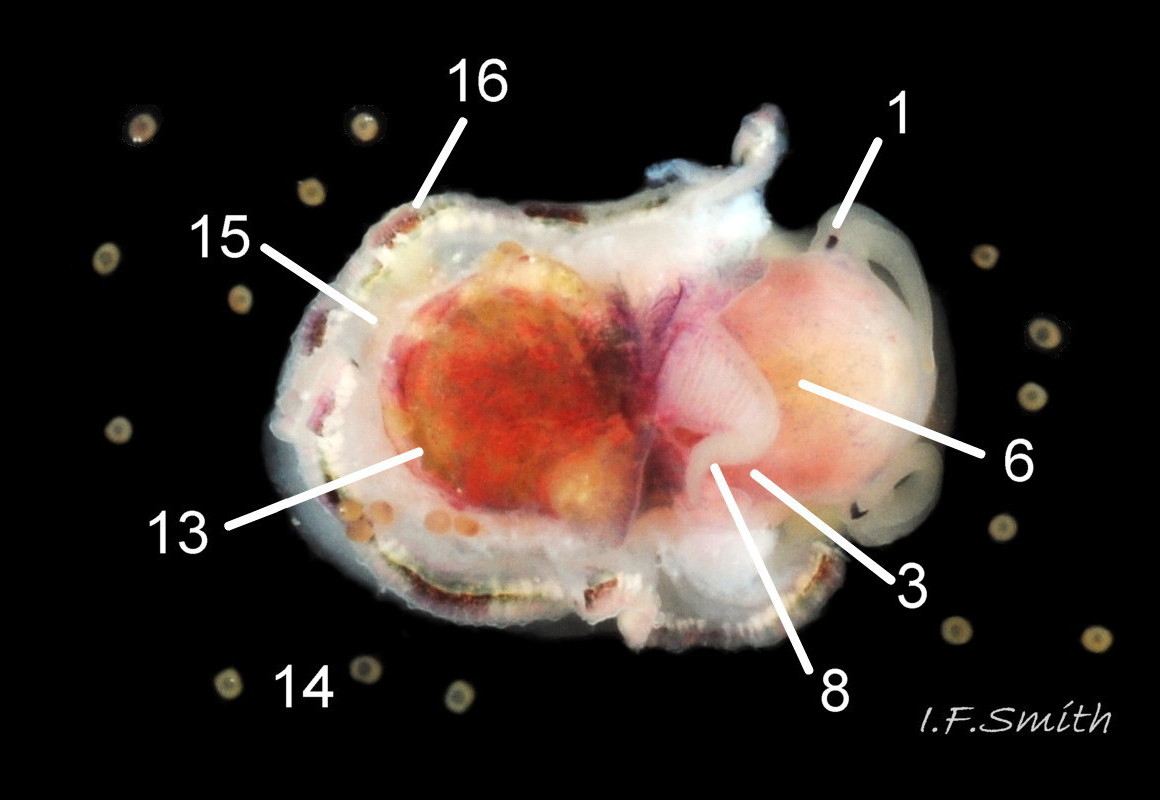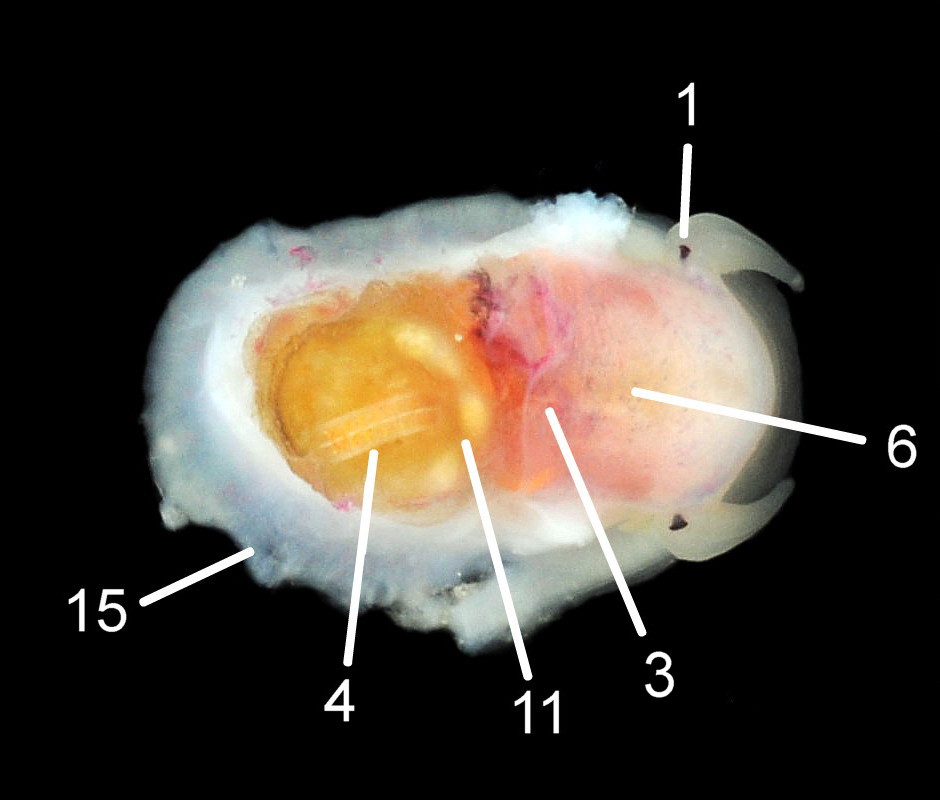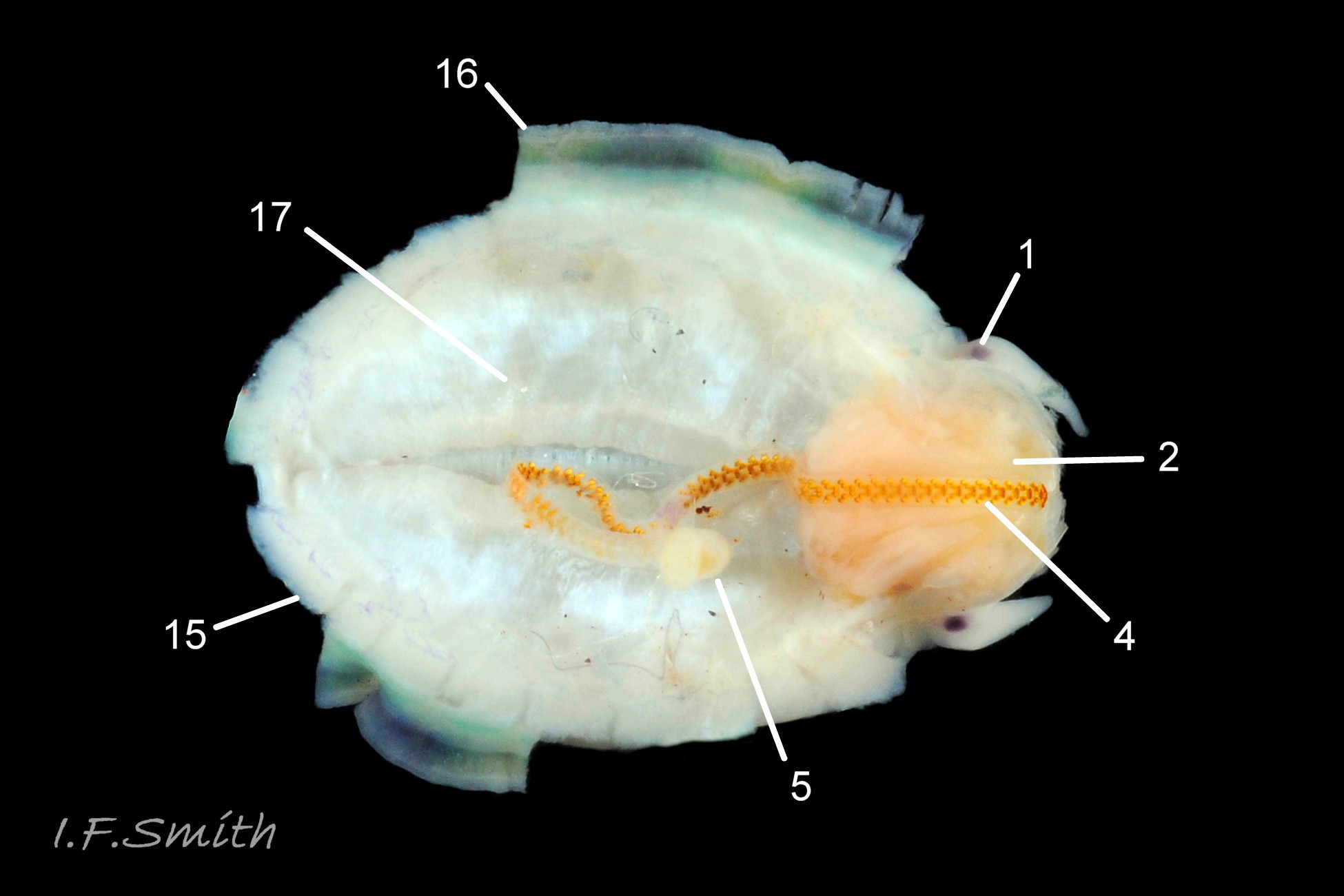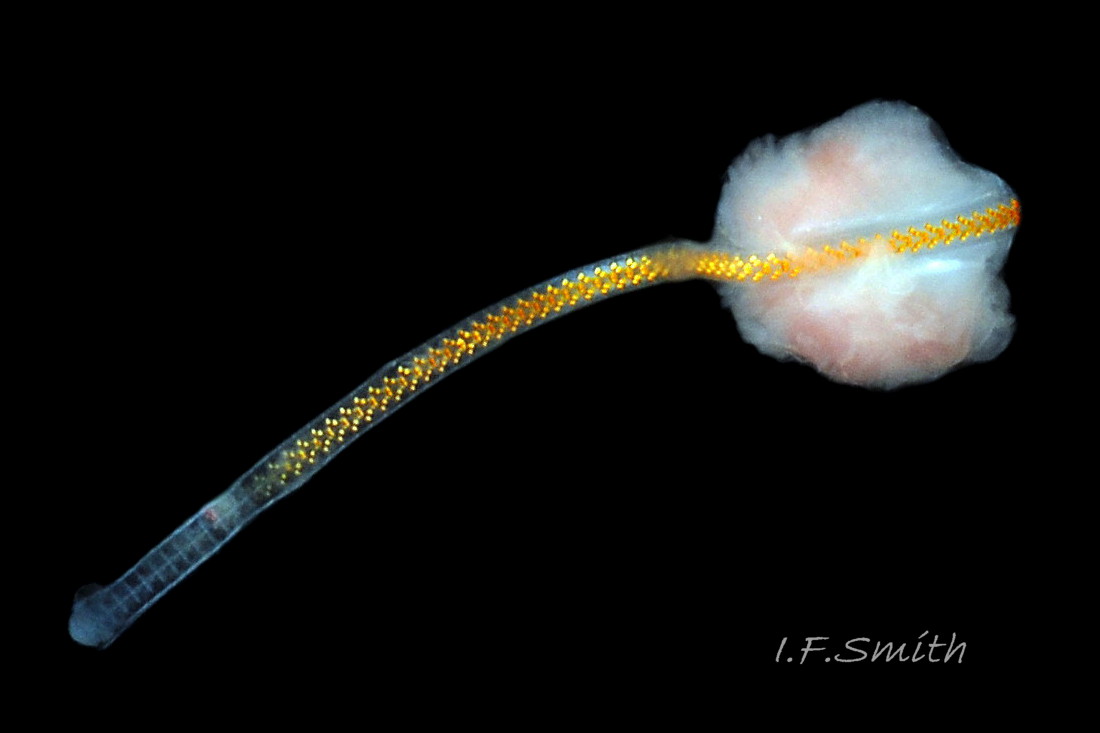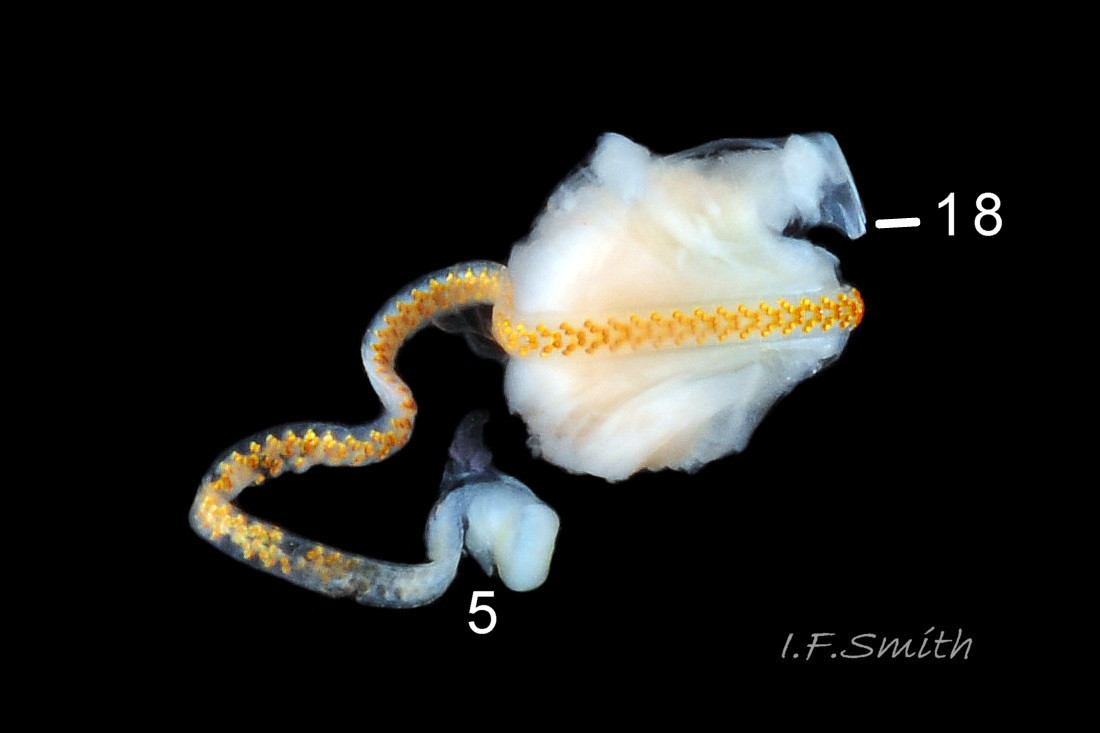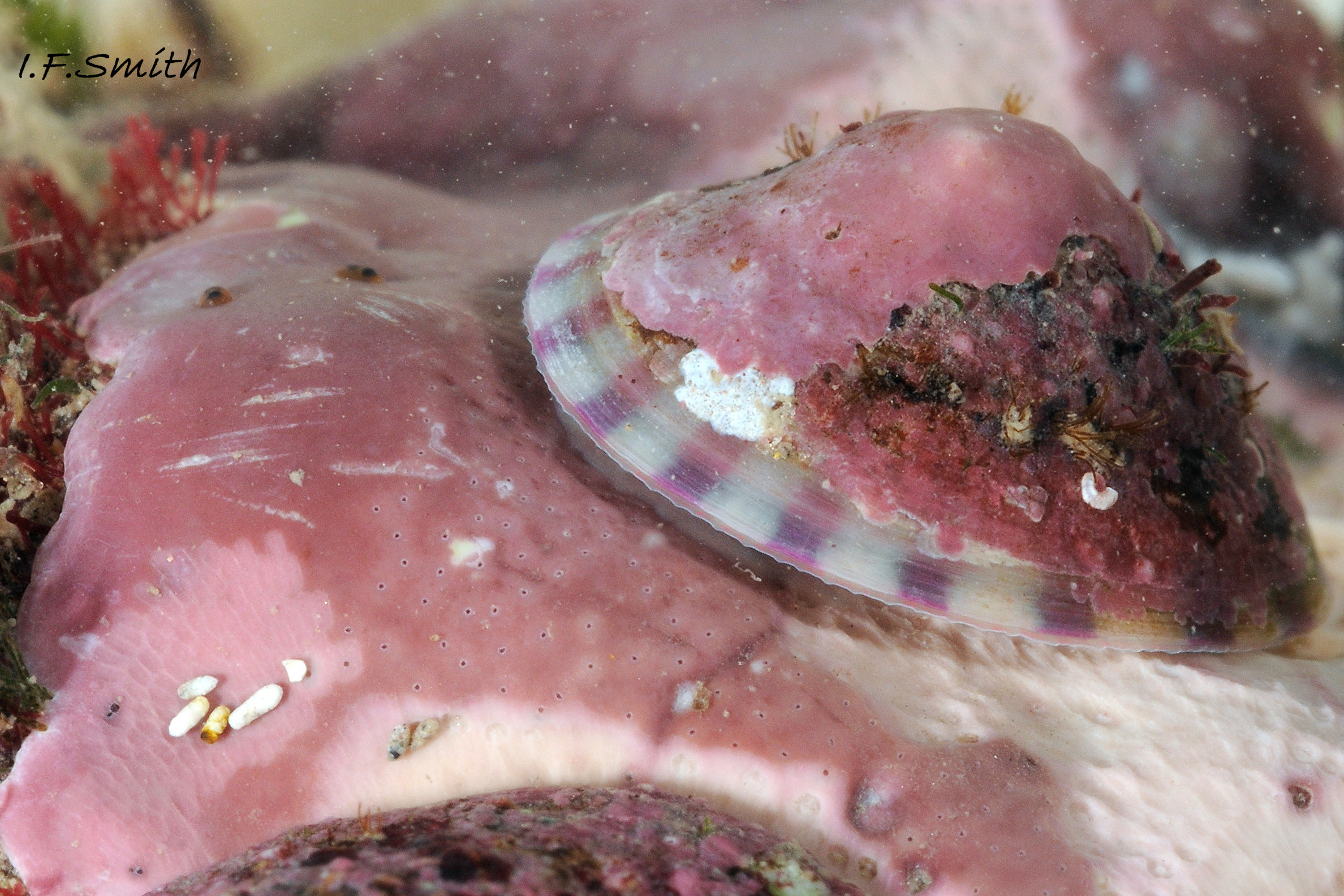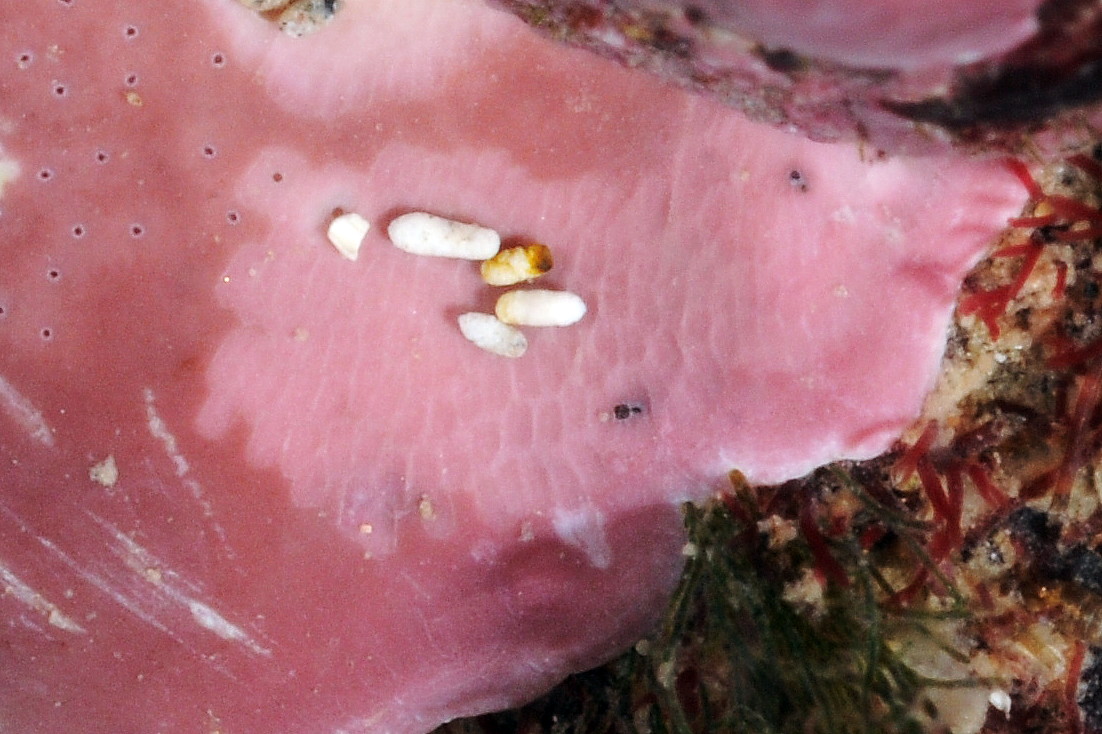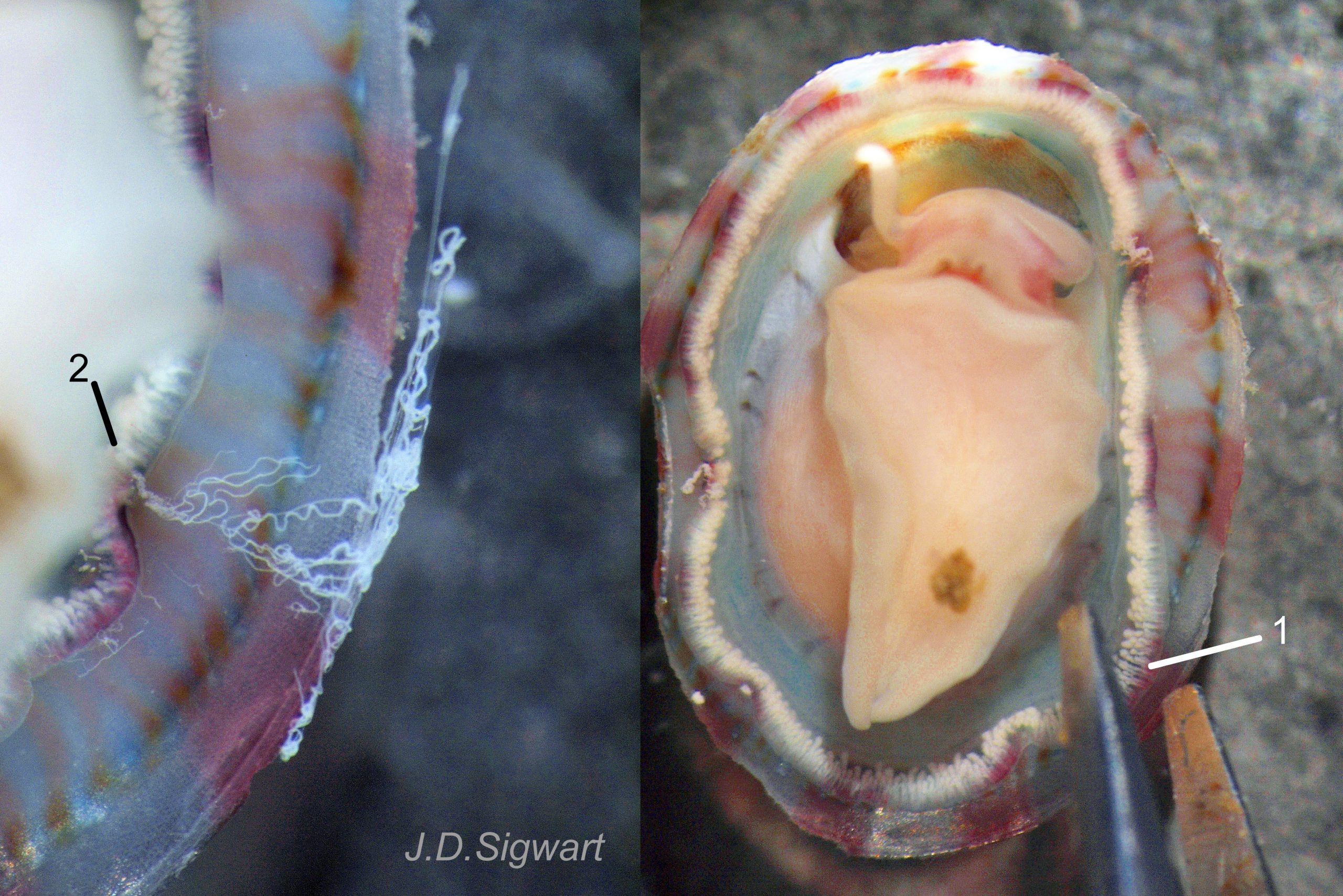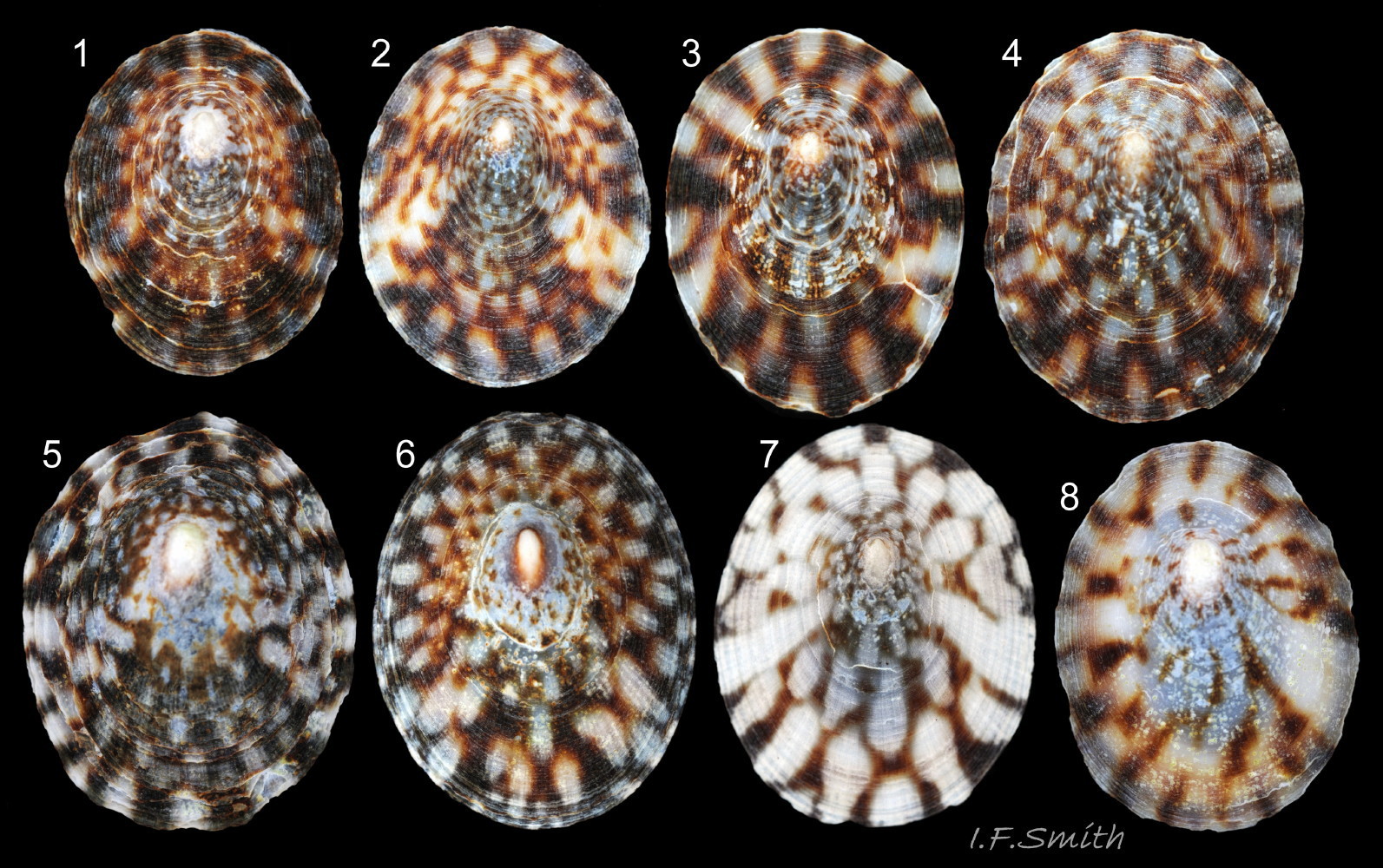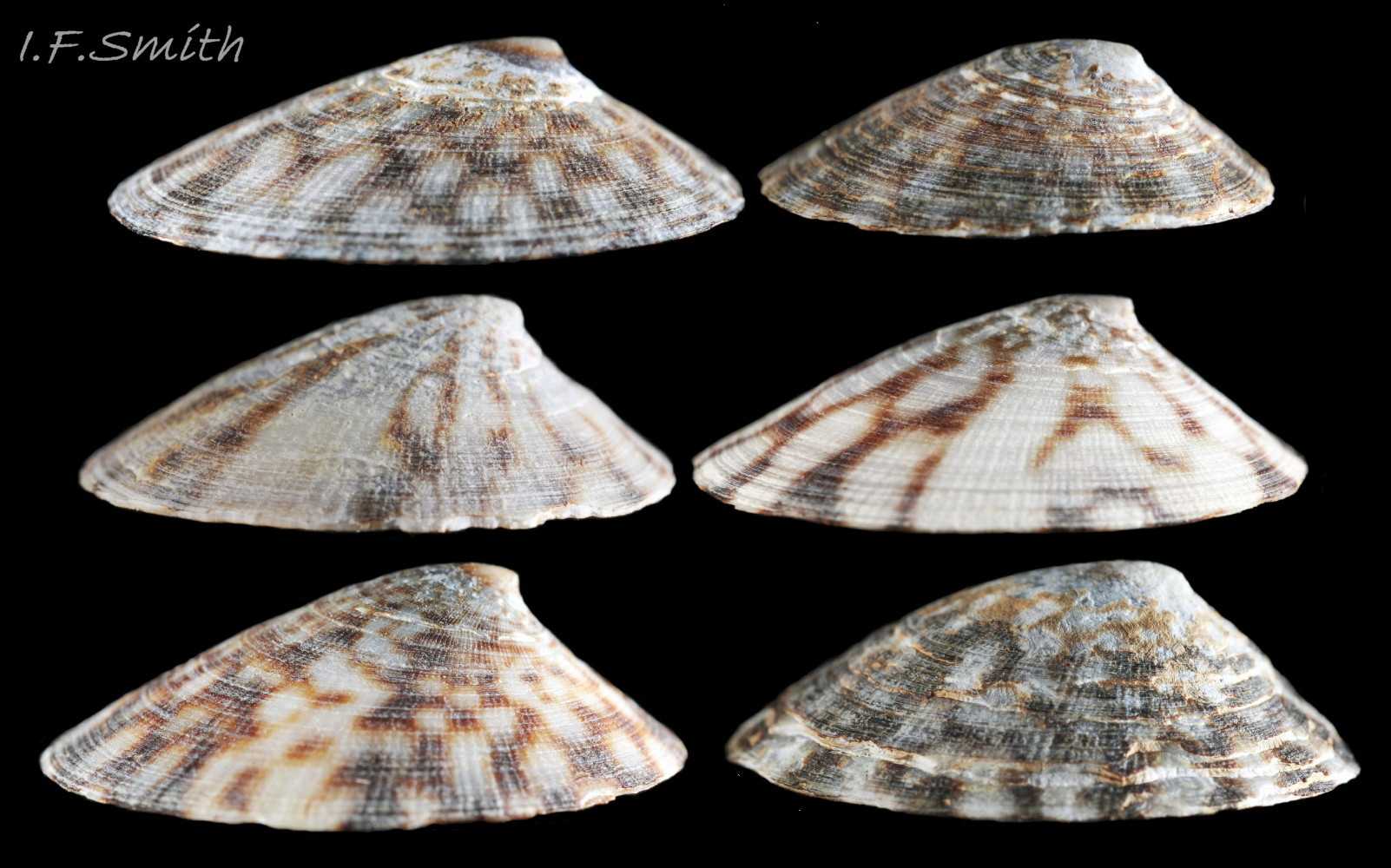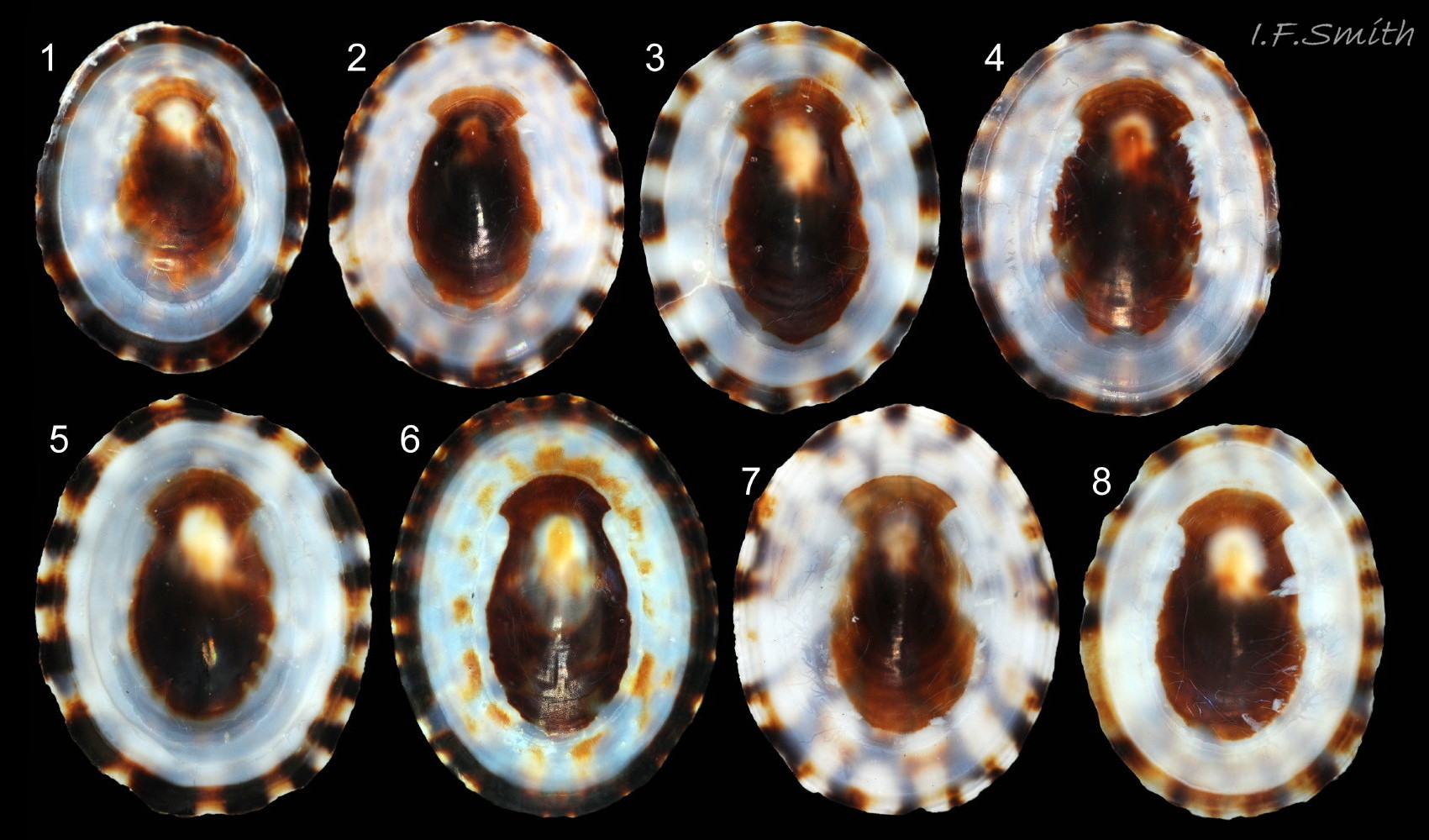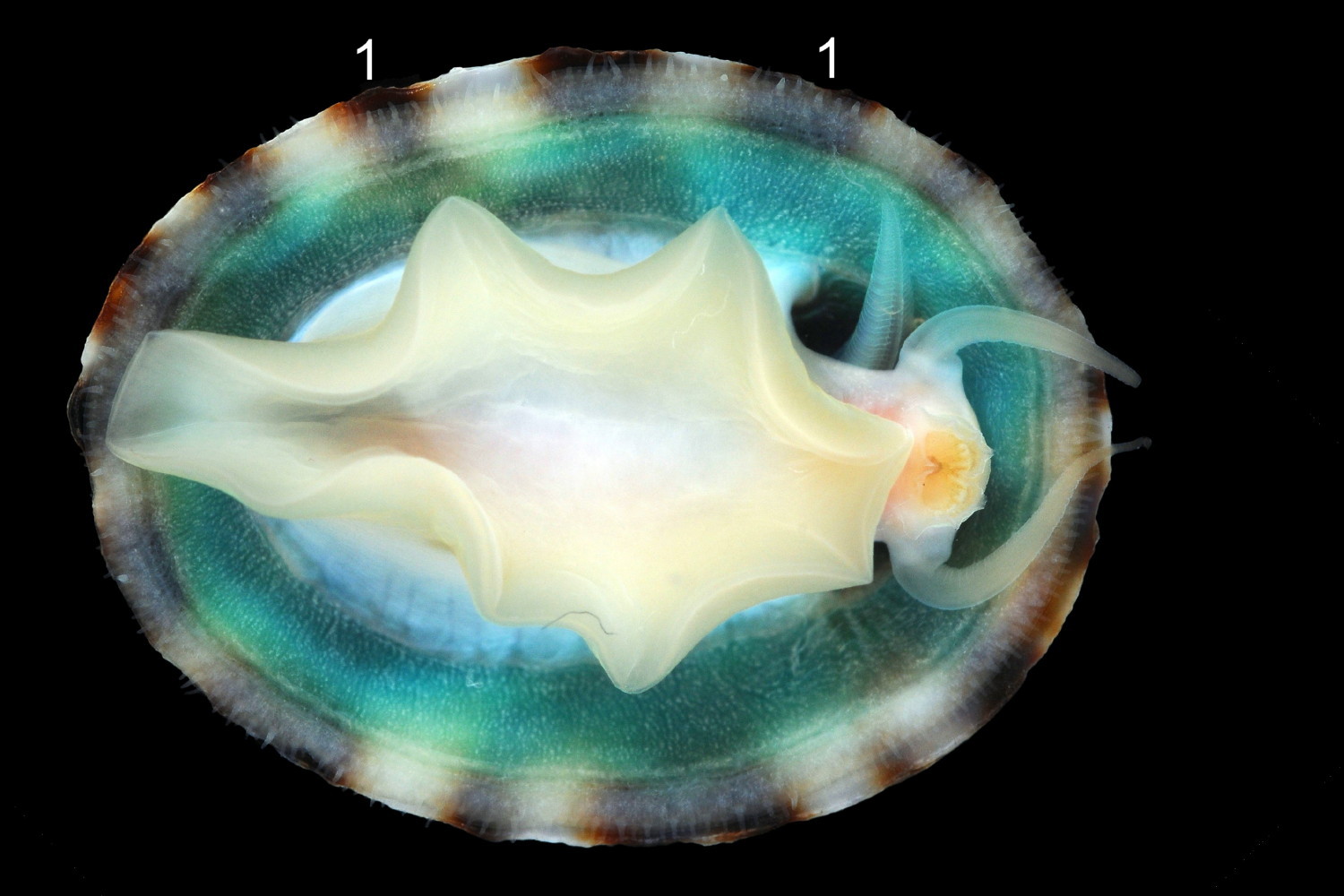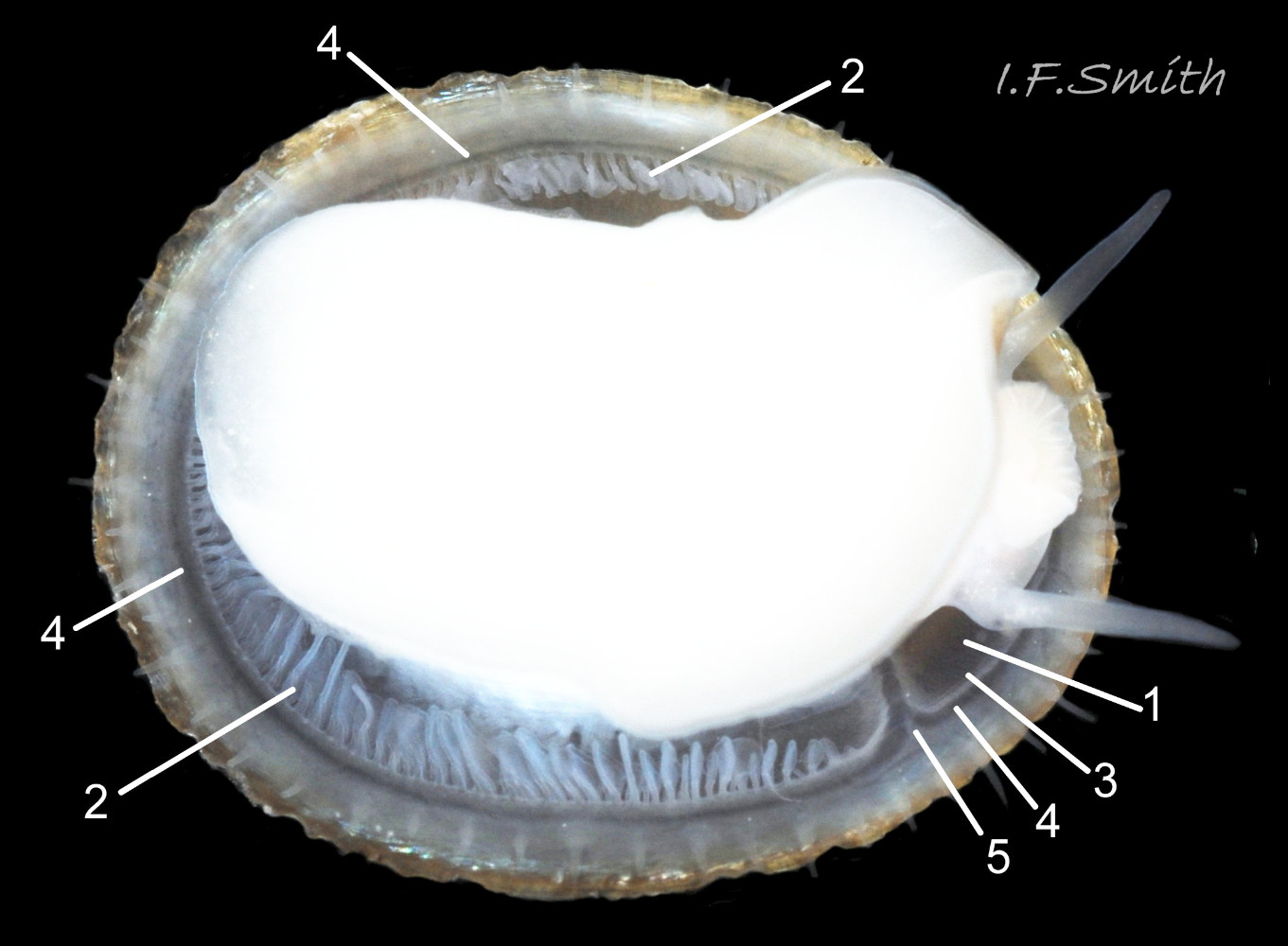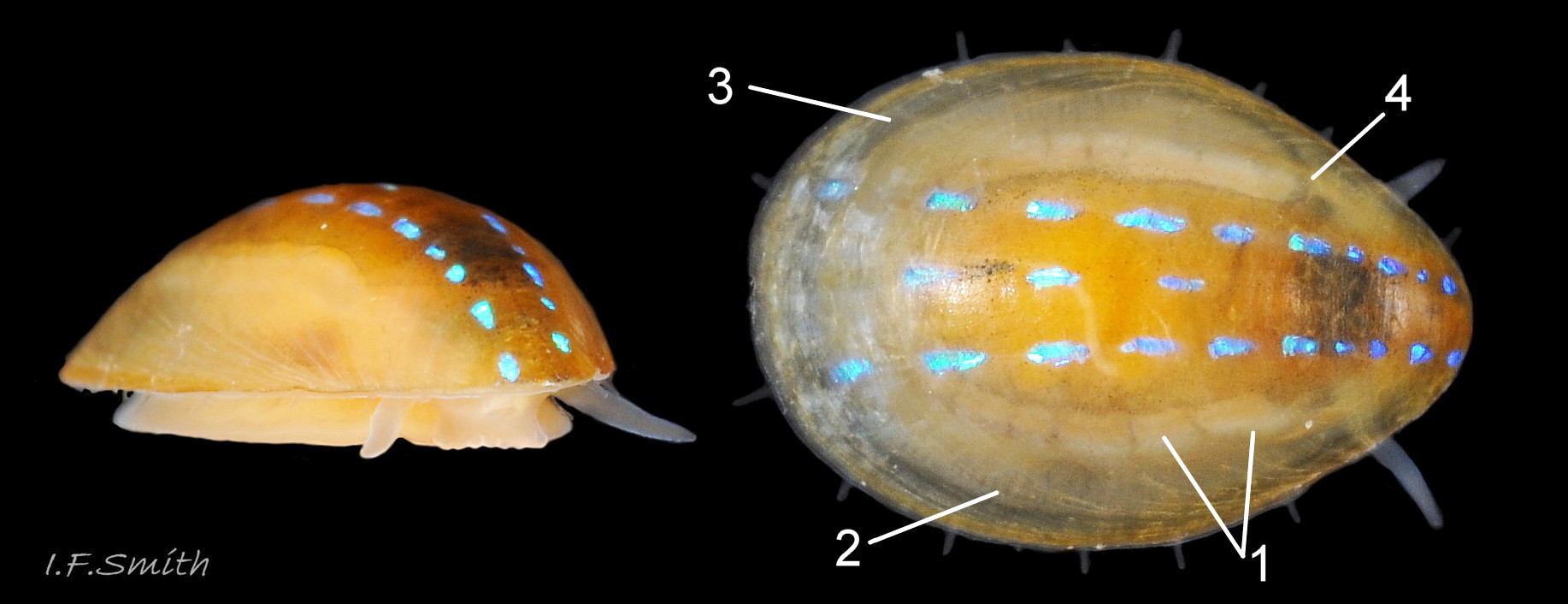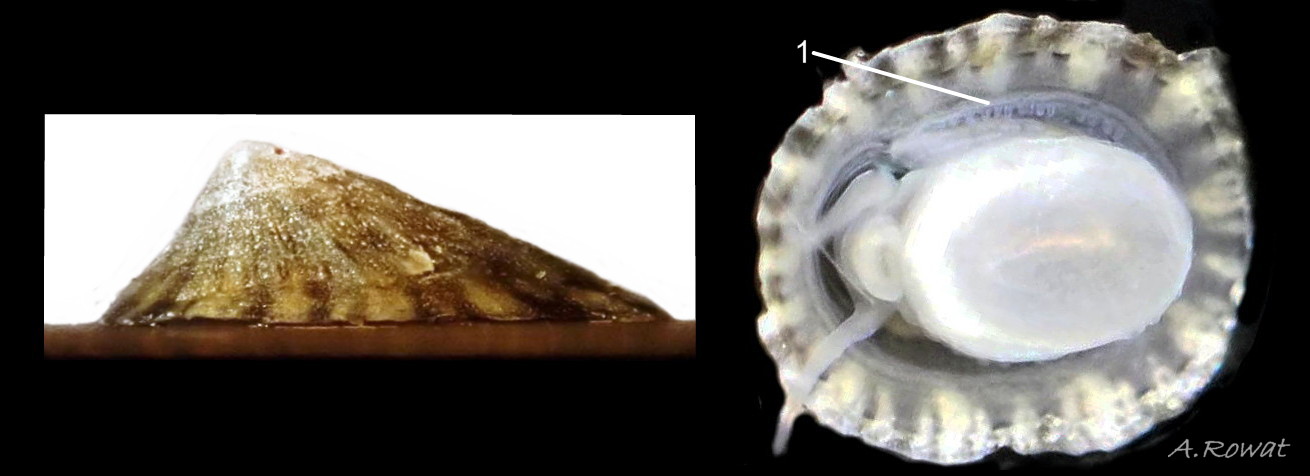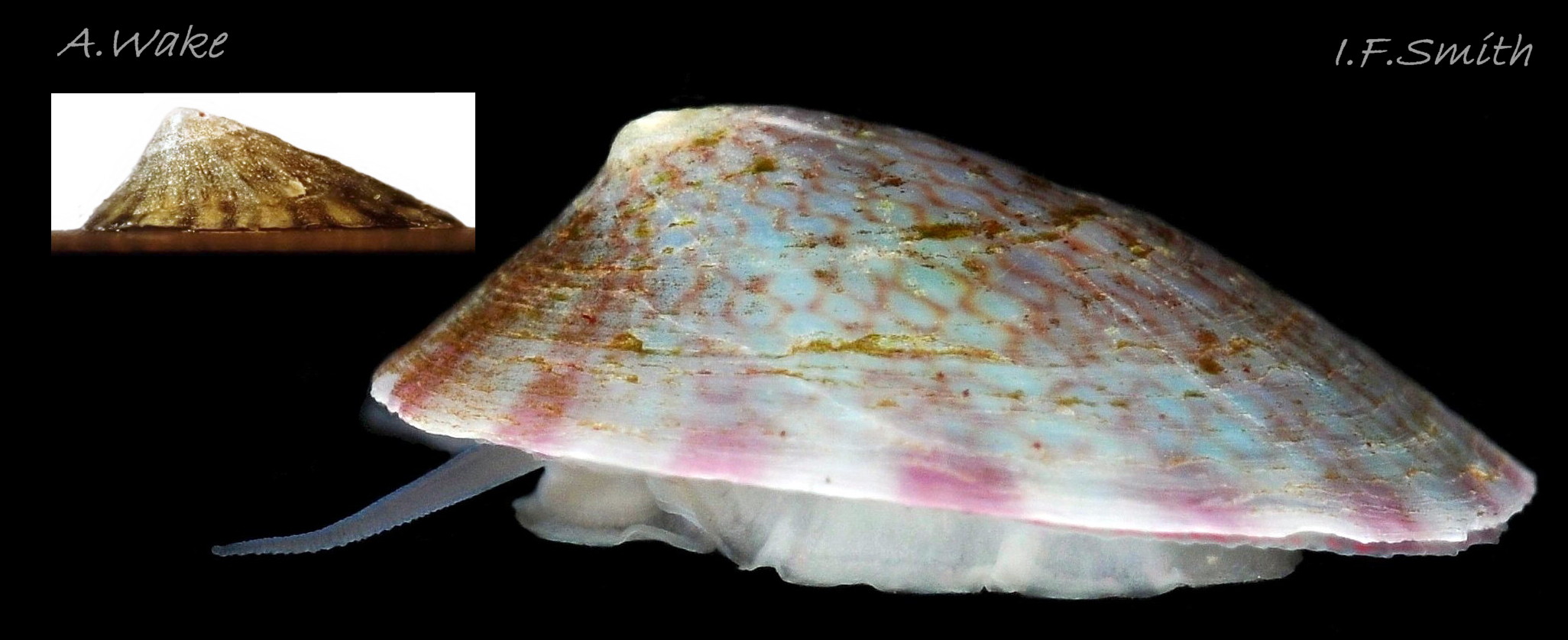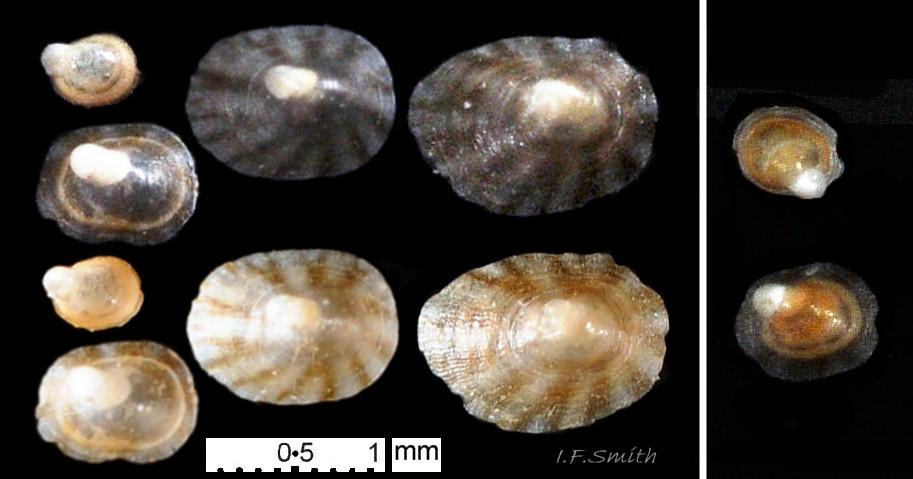Click image to enlarge with full caption. Main text below slider.
Tectura virginea (O.F. Müller, 1776)
Revised, 2020, PDF version at www.researchgate.net/profile/Ian_Smith19/research
Current taxonomy: World Register of Marine Species (WoRMS)
www.marinespecies.org/aphia.php?p=taxdetails&id=153552
Synonyms:Patella virginea O.F. Müller, 1776, 1776; Patelloida virginea (O.F. Müller, 1776); Acmaea virginea (O.F. Müller, 1776); Acmaea virginica in Yonge & Thompson, 1976;
Vernacular names: White tortoiseshell limpet; Pink-rayed limpet (English); Brenigen wen (Welsh); Stribet albueskael (Danish); schoteltje (Dutch); Jungfräuliche Napfschnecke (German); jomfrusnegl (Norwegian); jungfruskålsnäcka (Swedish);
GLOSSARY below.
Shell Description
Up to 12mm long. Often thin and fragile. Usually a low conoid 01 Tectura virginea, occasionally high. Excentric apex tilted forwards, usually 18% to 30% of shell-length from anterior; sometimes more central on sublittoral specimens. Base oval, sometimes widest at posterior 02 Tectura virginea. Anterior profile slightly concave; posterior profile slightly convex; often distinct changes in slope 03 Tectura virginea. Sculpture of slight threadlike radiating striae 02 Tectura virginea, often indistinct or absent 01 Tectura virginea , and numerous fine concentric growth lines, sometimes emphasised by algal growths 04 Tectura virginea; smooth surface unless coated with Lithothamnion 05 Tectura virginea. Young shells are translucent with a tiny, white, semi-spiral, apical protoconch 40 Tectura virginea discernible until the shell is about 1.5mm long, after which it is usually eroded. External ground colour of live shell whitish, often tinted pale-pink 01 Tectura virginea. or pale-blue 03 Tectura virginea. Central early growth usually patterned with tessellating chains of light brown, sometimes with bright blue spot in each link 03 Tectura virginea frequently worn off older shells 02 Tectura virginea. On later peripheral growth 16-20 flaring, radiating, pink to liver-coloured rays usually replace chains 06 Tectura virginea. Colours fade rapidly after death 02 Tectura virginea. Internally, shell often translucent whitish, with some exterior markings showing through 07 Tectura virginea; sometimes red-brown, complete or partial V with point near vertex and arms to posterior 02 Tectura virginea.
Older shells often lined with thin porcellaneous layer that reduces translucency and conceals exterior markings. In fresh shells, often distinct U-shape shell-muscle scar, broad peripheral whitish pallial band, and central white viscera patch 08 Tectura virgineaFragile shells soon beach-worn and faded after death; older shells and those reinforced by coating of Lithothamnion (opaque chalky white when dead) survive best and most frequently found on strand-line 09 Tectura virginea
Body description
Main colour of flesh white, yellowish or pinkish. Head has short stout snout with large mouth. When not feeding, outer lip forms large prominent ridge with loose lateral flaps around anterior and sides of mouth 10 Tectura virginea. When feeding, outer lip expands into translucent oral veil on substrate 11 Tectura virginea & 12 Tectura virginea. . Long, slender, unpigmented cephalic tentacles, wrinkled when not fully extended 11 Tectura virginea . Black eye on dorsum of base of each tentacle, but difficult to view when live as not extended beyond shell and, when viewed ventrally, usually obscured by tentacle 13 Tectura virginea ; also eye often unpigmented so obscure. Red buccal mass shows pink through parts of head 14 Tectura virginea. Mantle-skirt white 12 Tectura virginea, yellowish 13 Tectura virginea, or blue-green 14 Tectura virginea with reddish bands on periphery that produce corresponding rays of shell 14 Tectura virginea. Mantle cavity consists of nuchal cavity over head, and groove (lacking pallial gills) around periphery of foot 14 Tectura virginea. Substantial single ctenidium with short lamellae, colour similar to mantle, attached inside left of nuchal cavity and extends across to right 15Tv 15 Tectura virginea. Unlike in most gastropods, ctenidium not attached to cavity roof or floor, other than at its base, and lamellae lack internal skeleton, so able to contract to 50% of size and withdraw completely into nuchal cavity above head 14 Tectura virginea.; but tip sometimes visible over right “shoulder” 13 Tectura virginea. When animal moving, ctenidium often fully extended but hidden between shell and extended foot/outer lip 12 Tectura virginea, except occasionally tip protrudes beyond shell. Clear view of ctenidium possible when inverted animal stretches to right itself 16 Tectura virginea. Periphery of mantle has many large white ‘repugnatorial glands’ set back from mantle edge and connected to it by narrow white necks 14 Tectura virginea . Outer edge of mantle has many small, unobtrusive, translucent, cilia-bearing sensory processes 17 Tectura virginea . U of white muscle bundles 13 Tectura virginea (blood vessels pass through the gaps), may be tinted as mantle , attaches body/foot to shell 18 Tectura virginea Foot yellow 13 Tectura virginea or white 11 Tectura virginea; sole oval, sometimes shows viscera 19 Tectura virginea . When crawling, usually only long whitish cephalic tentacles 06 Tectura virginea, and occasionally tip of ctenidium, visible dorsally; and whitish sides of foot and head visible laterally 11 Tectura virginea; no epipodial tentacles on side of foot. No penis as fertilization external.
Internal anatomy visible with simple dissection
When shell is removed, whole mantle is exposed; part within U-shape shell-muscle is translucent so several features can be seen through it 20 Tectura virginea, but are more easily viewed if it is removed.
Key to images: 20 Tectura virginea, 21 Tectura virginea , 22 Tectura virginea, 23 Tectura virginea, 24 Tectura virginea, 25 Tectura virginea , 26 Tectura virginea ,
1: black or purple-black eye at base of cephalic tentacle. (images 21-24Tv)
2: yellow-buff odontophore supporting distal section of radula (image 24Tv)
3: buccal mass in translucent head (image 20-23Tv)
4: radula (images 23-26Tv)
5: radula sac enclosing proximal section of radula (24 & 26Tv)
6: yellow of radula visible through translucent head (images 22-23Tv)
7: roof of nuchal cavity (image 20Tv)
8: ctenidium, greatly contracted after death. (image 22Tv)
9: greyish stomach wall (images 20-21Tv)
10: digestive gland (images 20-21Tv)
11: rectum containing pale faecal pellets (image 23Tv)
12: yellow-buff male gonad (images 20-21Tv)
13: remains of ruptured female ovary (image 22Tv)
14: ova scattered from ovary (image 22Tv)
15: severed U shape shell-muscle (images 20-24Tv)
16: mantle skirt (images 20-22Tv & 24Tv)
17: muscles of left side of sole (image 24Tv)
18: jaw (image 26Tv)
cartilage of odontophore (image 25Tv)
Key identification features
Young Patella spp., can resemble worn specimens of T. testudinalis.
Tectura virginea
1) Maximum length 12 mm.
2) Shell exterior whitish/yellowish/bluish with pinkish or brownish rays and chains 11 Tectura virginea Worn specimens of T. virginea are often mistaken for T. testudinalis; examination of the foot and pallial groove or shell interior is necessary in such cases 34 Tectura virginea. Young T. virginea with blue spots 03 Tectura virgineaoften confused with early stage Patella pellucida 36 Tectura virginea .
3) Shell interior white, often shows exterior marks, sometimes red-brown V at vertex 02 Tectura virginea.
4) Threadlike radial striae and fine concentric growth lines 02 Tectura virginea often indistinct 01 Tectura virginea.
5) Mantle-skirt white, yellowish, or blue-green with inwardly oriented, large, white glands, and reddish bands on periphery 12 Tectura virginea, 13 Tectura virginea& 14 Tectura virginea. Ctenidium, no pallial gills 16 Tectura virginea.
6) Many unobtrusive, translucent processes on mantle edge, but no pallial tentacles 17 17 Tectura virginea.
7) All Britain except NE Irish Sea and parts of SE England. On encrusted rock, not seaweeds.
8) Apex 18% to 30% of length from anterior 02 Tectura virginea.
Similar species
Testudinalia testudinalis (O. F. Müller, 1776)
1) Maximum length usually 20 mm, occasionally 25 mm 31 Tectura virginea.
2) Shell exterior matt-whitish with radiating dark brown rays that often bifurcate and reunite across the shell 30 Tectura virginea.
3) Shell interior porcelaneous-white with brown-banded peripheral border, and dark brown viscera patch, usually with pale vertex patch 33 Tectura virginea .
4) Fine concentric growth lines and radiating striae 32 Tectura virginea.
5) Mantle skirt green in pallial groove, no red bands or large white glands on mantle periphery. Ctenidium, no pallial gills 34 Tectura virginea.
6) Large pallial tentacles protrude beyond shell perimeter when active 34 Tectura virginea.
7) North U.K, to Anglesey and N. Yorkshire. Many absence records, misleadingly, mapped further south on NBN with same symbol as for presence. On encrusted rock, not on seaweeds. records.nbnatlas.org/occurrences/search?q=lsid:NHMSYS0021…
8) Apex c. 25% to 40% of length from anterior 32 Tectura virginea.
Patella pellucida Linnaeus, 1758 [early stage, length 2 to 7mm]
1) Maximum length of development stage 7 mm.
2) Shell exterior translucent pale horn to light brown with blue/green hyphens in longitudinal rows 36 Tectura virginea. not in links of a chain pattern like that on some young T. virginea 03 Tectura virginea
3) Shell interior pale horn to light brown with black, colloidal particles under parts of the blue/green hyphens.
4) Smooth fragile shell 36 Tectura virginea .
5) Mantle-skirt translucent whitish. Pallial gills, no ctenidium in nuchal cavity. No inwardly oriented, large, white repugnatorial glands or reddish bands on mantle periphery 35 Tectura virginea.
6) pallial tentacles protrude from aperture rim, but unobtrusive as translucent and almost invisible 35 Tectura virginea.
7) All round Britain except Liverpool Bay and parts of SE England. On Laminaria, not rock, when > 2mm long.
8) Apex lost from anterior rim of aperture 36 Tectura virginea.
Williamia gussoni (Costa O. G., 1829)
37 Tectura virginea
1) Usual shell length c. 6 mm. Maximum L. c. 8 mm, W. 6 mm and H. 3 mm (Ruthensteiner, 2006); L. 8.8 mm (P. Ugarković, 2020 pers. comm.)
2) Exterior of shell is shiny, bright red-brown with c. 18 pale radiating rays that are sometimes obscured or faded when dead. Periostracum extends well beyond rim of shell.
3) Shell interior as exterior, but paler.
4) Thin, smooth shell with convex anterior and posterior slopes.
5) Mantle is translucent, red-brown with radiating, opaque white rays which correlate with pale rays of shell. No inwardly oriented, large, white repugnatorial glands. In Siphonariidae; respires with c. 17 lamellae concealed in mantle cavity; no pallial gills or protruding ctenidium plume.
6) No pallial tentacles. Cephalic tentacular lobes separated from large flat head by small cleft. Large flap-like anal lobe protrudes from mantle cavity on right. Dorsal surface of head and foot are red-brown; ventrally yellowish white
7) Common at Low Water to more than 50 m (J. Prkić, 2020, pers. comm.) in Adriatic, Mediterranean and adjacent Atlantic; not N.W. Europe (Ruthensteiner, 2006).
8) Apex has distinct semi-spiral protoconch positioned off-centre posteriorly, sometimes overhanging beyond the posterior of the aperture.
Habits and ecology
On rocky shores where turbidity doesn’t prevent plant growth; at LWST (higher level if in pools) and to 100m depth. Occurs and feeds on pink Lithothamnion algae encrusting bedrock and stable stones 27Tv 27 Tectura virginea. Diatoms, Chondrus crispus and Cystoseira also reported as food (Fretter & Graham, 1962). So long as not arid, tops of encrusted stones and rocks apparently preferred, perhaps to avoid silt, but also where light allows Lithothamnion to grow. Hard iron-mineralized radula, longer than shell to allow for replacement of teeth worn away on rock, aided by pair of grab-like, lateral, chitinized jaws, 26 Tectura virginea produces a distinctive network of feeding pits in surface of Lithothamnion 28 Tectura virginea; initially paler-pink than undamaged surface but later bleaching white as Lithothamnion is killed 27 Tectura virginea. Wide outer lip spreads out flat on substrate during feeding 11 Tectura virginea, contains many sensory structures; possible functions to detect Lithothamnion, locate mouth precisely to avoid overlap with previous feeding pit without missing part of food, and to retain loose fragments (function of anterior scraper-jaw on Patella spp.; missing from T. virginea). Long coiled intestine compacts faeces into firm white pellets 23 Tectura virginea that will not contaminate ctenidium near anus in nuchal cavity (T. virginea lacks a hypobranchial gland to produce mucus to bind faecal fragments). After defecation, pellets carried by exhalent respiratory current to posterior of animal to accumulate under shell 28 Tectura virginea.before periodic sharp contraction of shell-muscle clamps shell down to expel water and faeces.
Defence: when on Lithothamnion, colour cryptic, and chain pattern 03 Tectura virginea resembles feeding pits 28 Tectura virginea ; also shell often has covering of Lithothamnion 05 Tectura virginea Cilia-bearing sensory processes on outer edge of mantle 17 Tectura virginea. probably sense attack. In response to strong stimulation (e.g. pressure from forceps) white repugnatorial glands on mantle-fringe 14 Tectura virgineaemit secretion of viscid, slow-to disperse, white threads (presumed by Fretter & Graham, 1962, to be distasteful and/or toxic) 29 Tectura virginea.
Breeds in spring (April-May in Roscoff); shedding of sperm into water by males (probably proximate, perhaps on female’s shell like Testudinalia testudinalis) stimulates females to release eggs individually 22 Tectura virginea. Eggs hatch as free trochophore larvae (stage passed within egg by most less “primitive” spp.) in plankton before transforming to veligers and, after a short pelagic life, settling and assuming limpet form with the white, semi-spiral, veliger shell at the apex as a protoconch 40 Tectura virginea. The protoconch is usually eroded away after the shell is about 1.5 mm long.
Respiration: cilia on ctenidium create inhalent water current into left of nuchal cavity, then between ctenidial filaments to oxygenate blood within, and thence as exhalent current along pallial groove on each side of foot to exit at posterior of limpet 18 Tectura virginea. Although no pallial gills, respiration probably also occurs in pallial groove as most blood from head and pedal veins passes in veins through gaps between shell-muscle bundles into mantle and collects in peripheral efferent pallial vessel 18 Tectura virginea (Fretter & Graham, 1962) that probably acquires oxygen from current generated by ctenidium and/or external water at shell’s edge. Blood passes from efferent pallial vessel to heart without going through ctenidium 10 Tectura virginea. When emersed, mantle cavity drains and ctenidium collapses, but roof of richly-vascularized cavity stays damp and functions for gas exchange sufficiently for respiration for short periods.
Distribution and status
Iceland and Kola Peninsula (N. Russia) to Senegal and into Mediterranean, not Baltic. GBIF map www.gbif.org/species/5191383 No record has been found of it living intertidally in the Mediterranean (J. Prkić, Croatia and G. Bazios, Greece, 2020, pers. comm.). Frequent all round Britain and Ireland on hard substrate in non-turbid water. Frequent all round Britain and Ireland on hard substrate in non-turbid water. It is absent, or rare, in Liverpool Bay and further south than Flamborough Head to Kent. U.K. map NBN species.nbnatlas.org/species/NHMSYS0021056385
Acknowledgements
I should like to thank Dr Ivan Nekhaev and Dr Julia Sigwart, for advice with the text and interpretation of the images. I thank Jakov Prkić and Pero Ugarković for information and use of images, Simon Taylor and Andrew Wright for specimens and Ann Wake and Allan Rowat for use of images. Any errors or omissions are the responsibility of the author.
Links and references
Forbes, E. & Hanley S. 1849-53. A history of the British mollusca and their shells. vol. 2 (1849), London, van Voorst. (As Acmaea virginea; Free PDF at archive.org/stream/historyofbritish02forb#page/436/mode/2up Use slide at base of page to select pp.437-440.)
Fretter, V. and Graham, A. 1962. British prosobranch molluscs. London, Ray Society.
Graham, A. 1988. Prosobranch and pyramidellid gastropods. London.
Jeffreys, J.G. 1862-69. British conchology. vol. 3 (1865). London, van Voorst. (As Tectura virginea; Free PDF at archive.org/stream/britishconcholog03jeff#page/248/mode/2up . Use slide at base of page to select pp.248- 250.
Yonge, C.M. and Thompson, T.E. 1976. Living marine molluscs. London.
Current taxonomy: World Register of Marine Species (WoRMS)
www.marinespecies.org/aphia.php?p=taxdetails&id=153552
GLOSSARY
aperture =– mouth of gastropod shell; outlet for head and foot.
cephalic =– (adj.) of or on the head.
ctenidium = comb-like molluscan gill; usually an axis with a row of filaments either side.
ELWS = extreme low water spring tide (usually near March and September equinoxes).
epipodial (adj.) = of the epipodium (collar or circlet running round sides of foot of some gastropods).
mantle = sheet of tissue that secretes the shell and forms a cavity for the gill in most marine molluscs.
MLWS = mean low water spring tide level (mean level reached by lowest low tides for a few days every fortnight; Laminaria or Coralline zone on rocky coasts).
periostracum = thin horny layer of chitinous material often coating shells.
trochophore = spherical or pear-shaped larva that swims with aid of girdle of cilia. Stage preceding veliger, passed within gastropod egg in most spp. but free in plankton for patellid limpets, most Trochidae and Tricolia pullus.
veliger = shelled larva of marine gastropod or bivalve mollusc which swims by beating cilia of a velum (bilobed flap).
